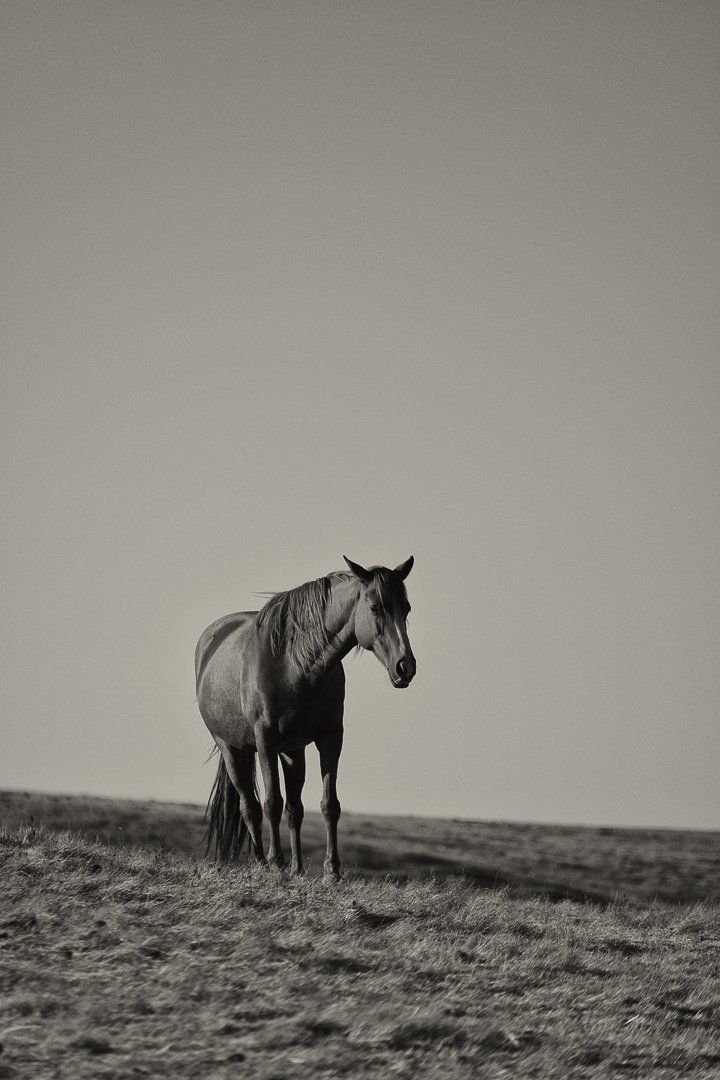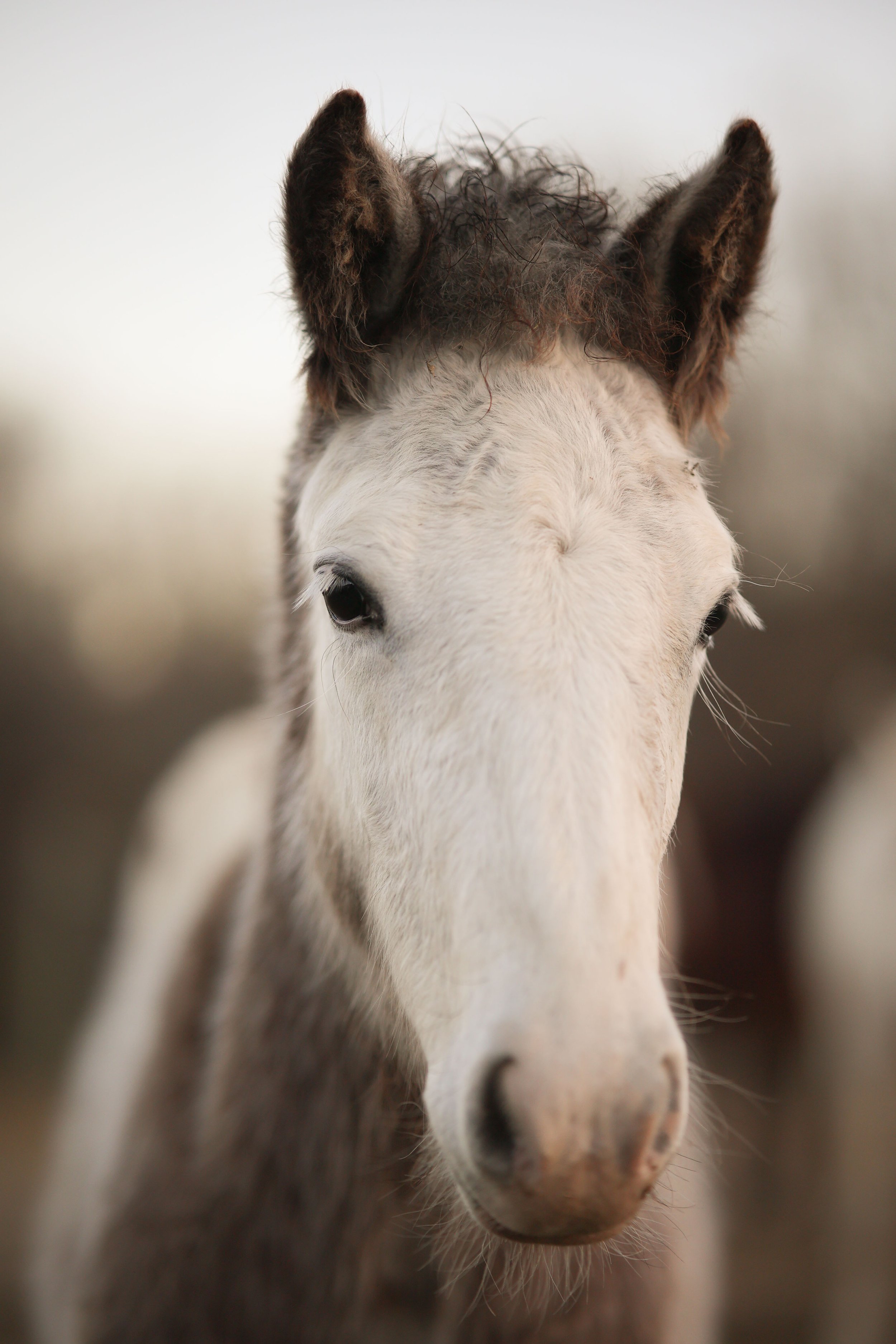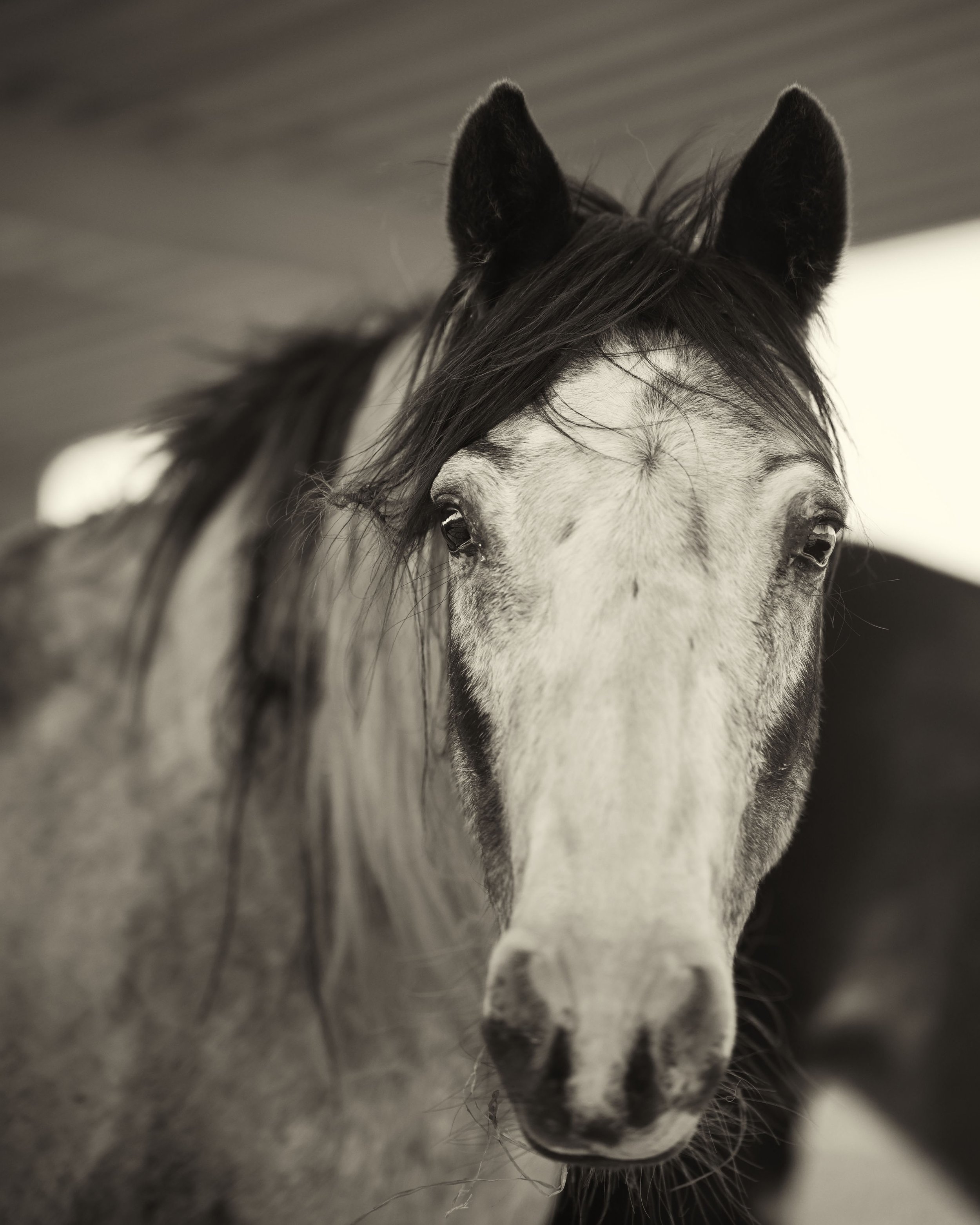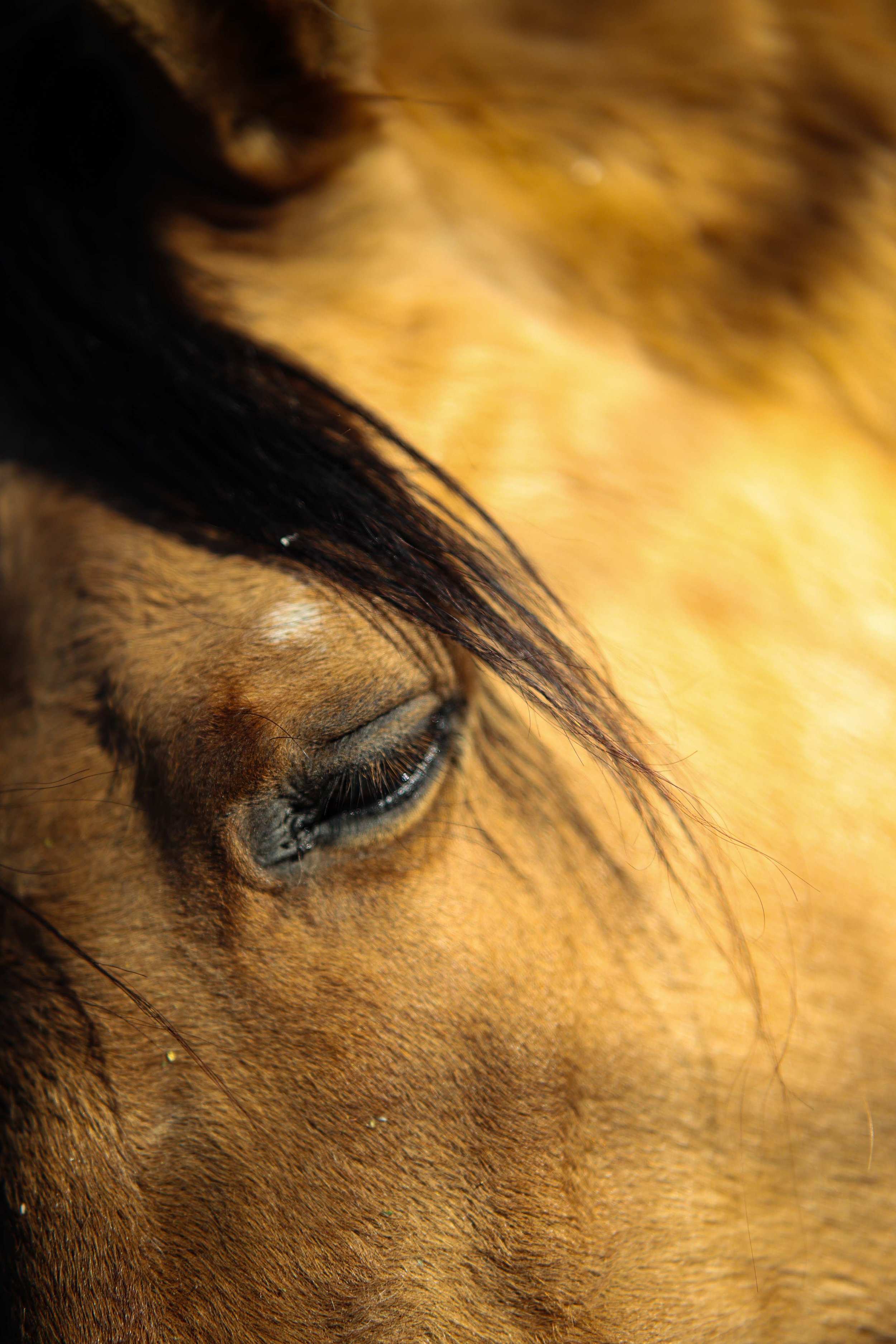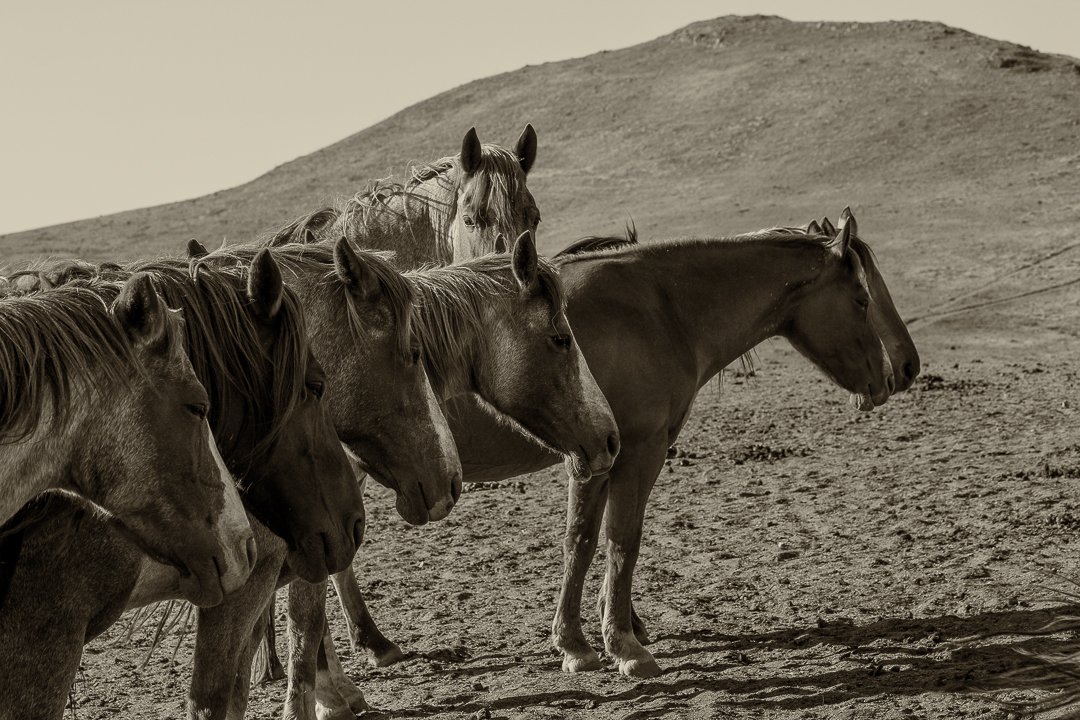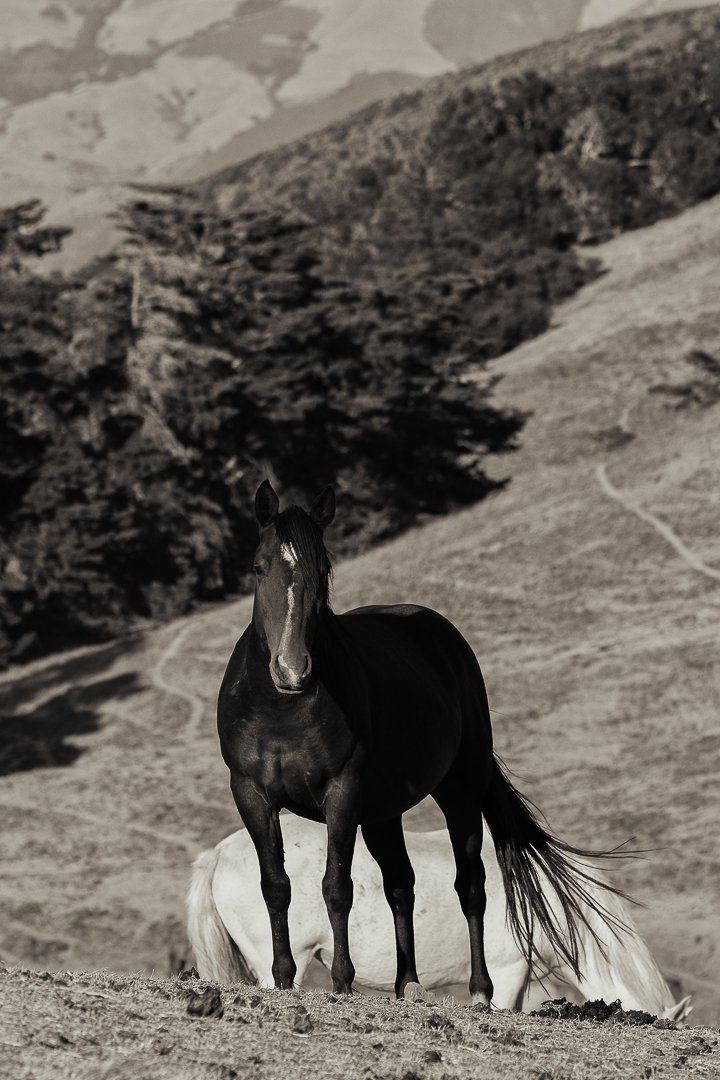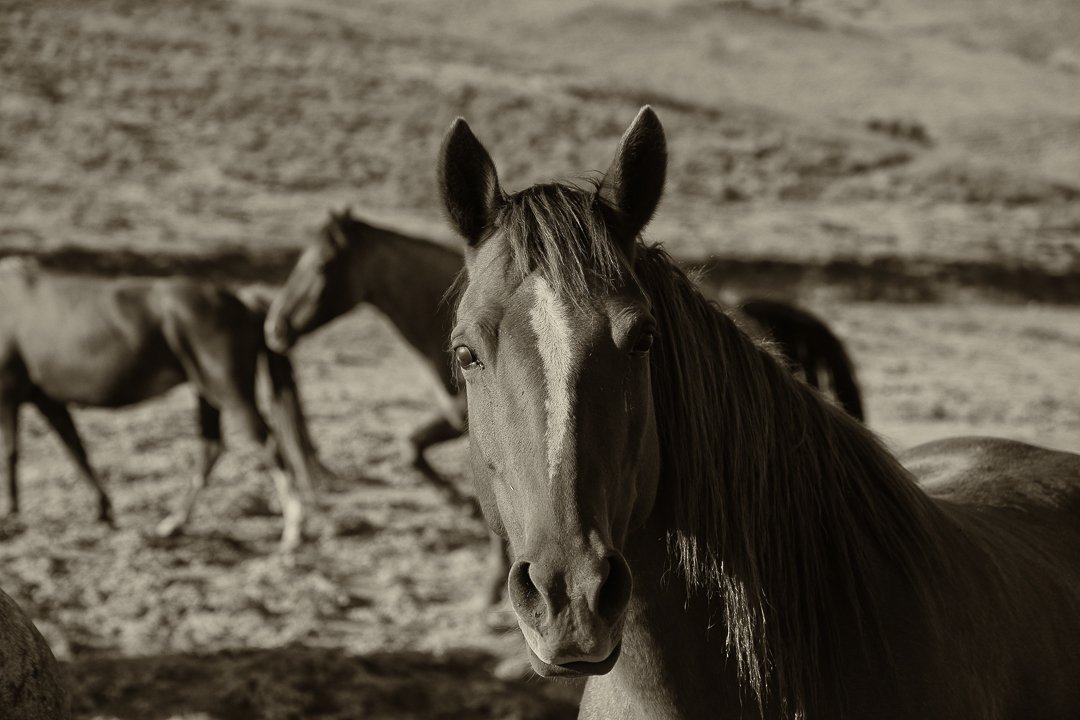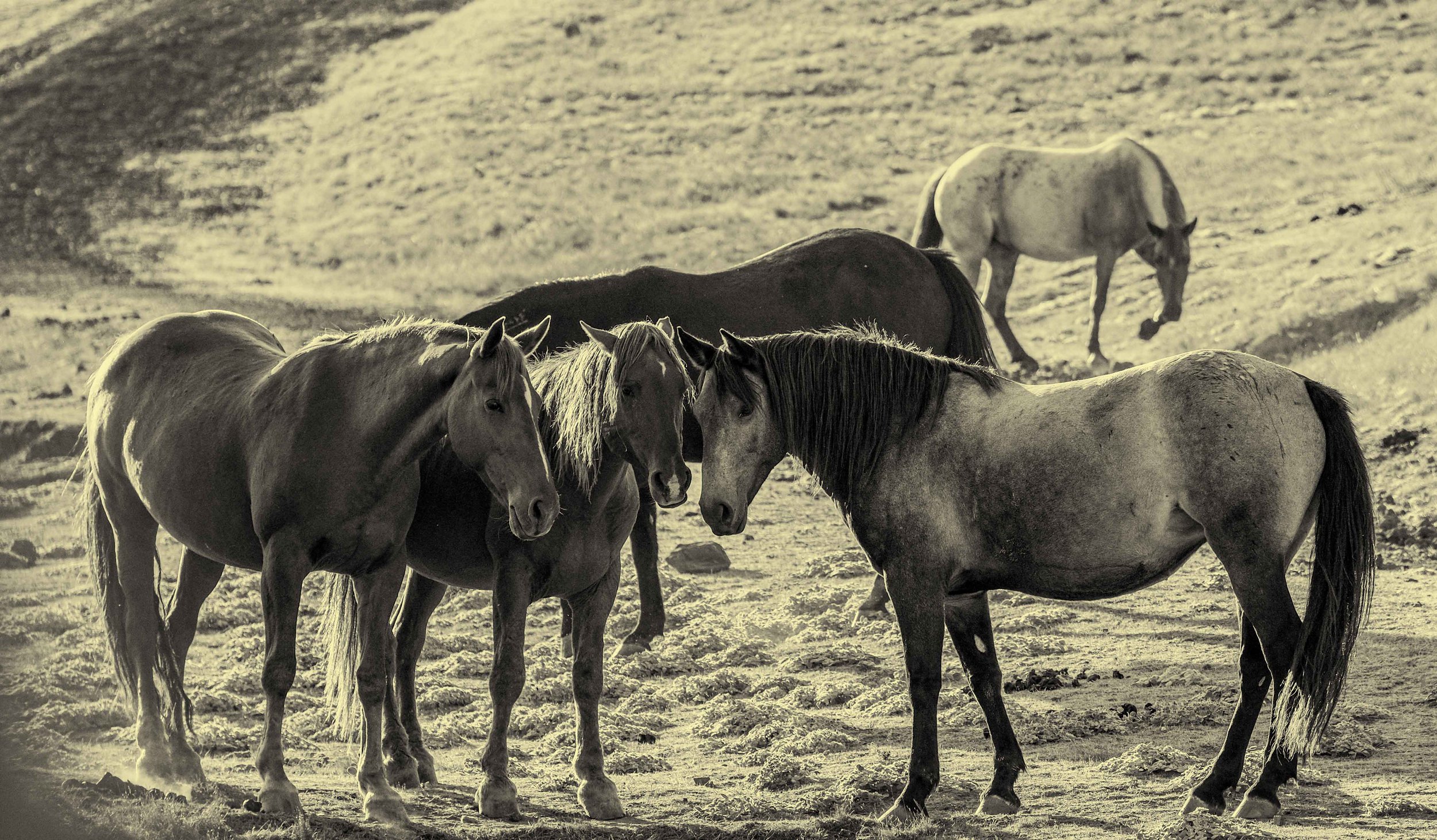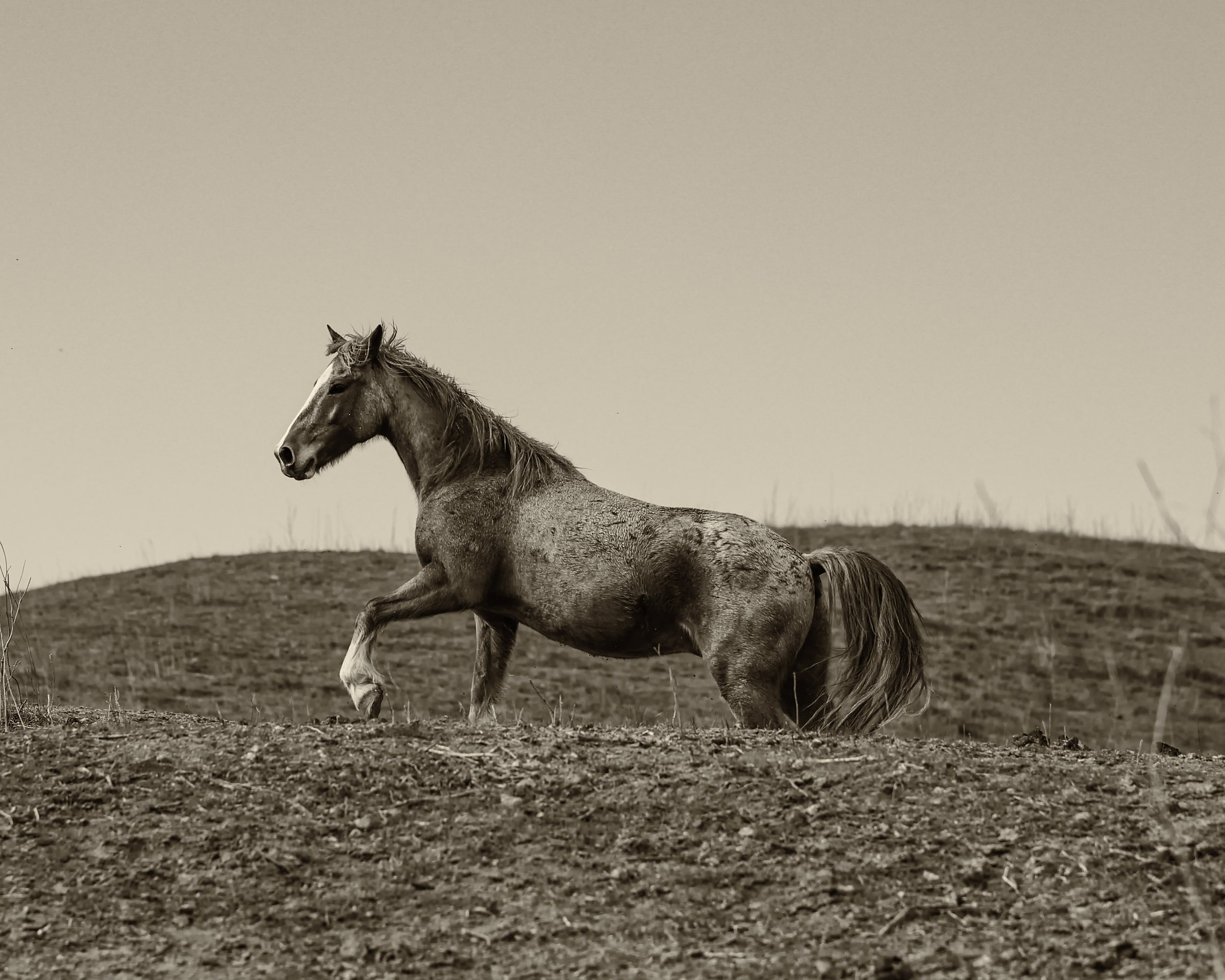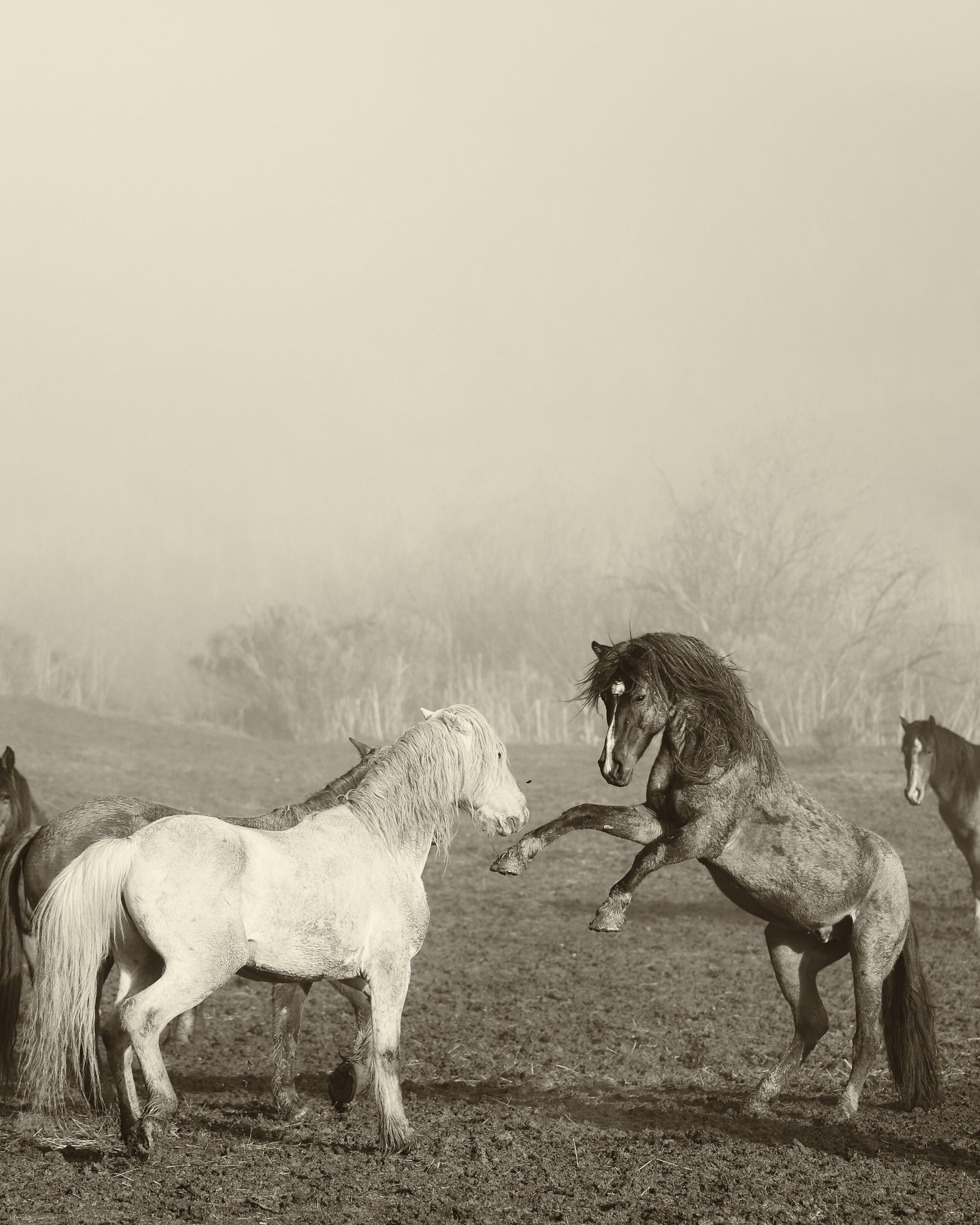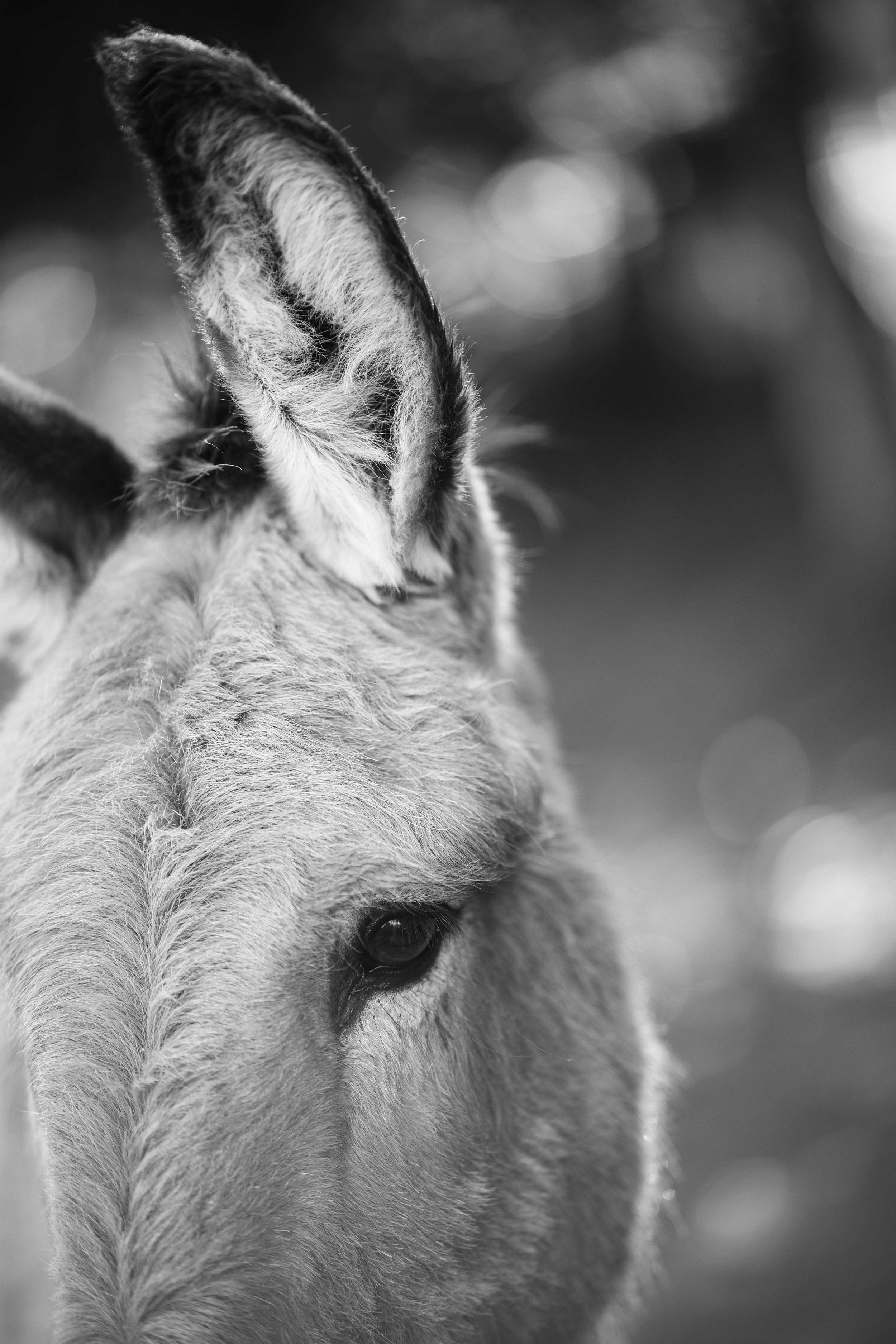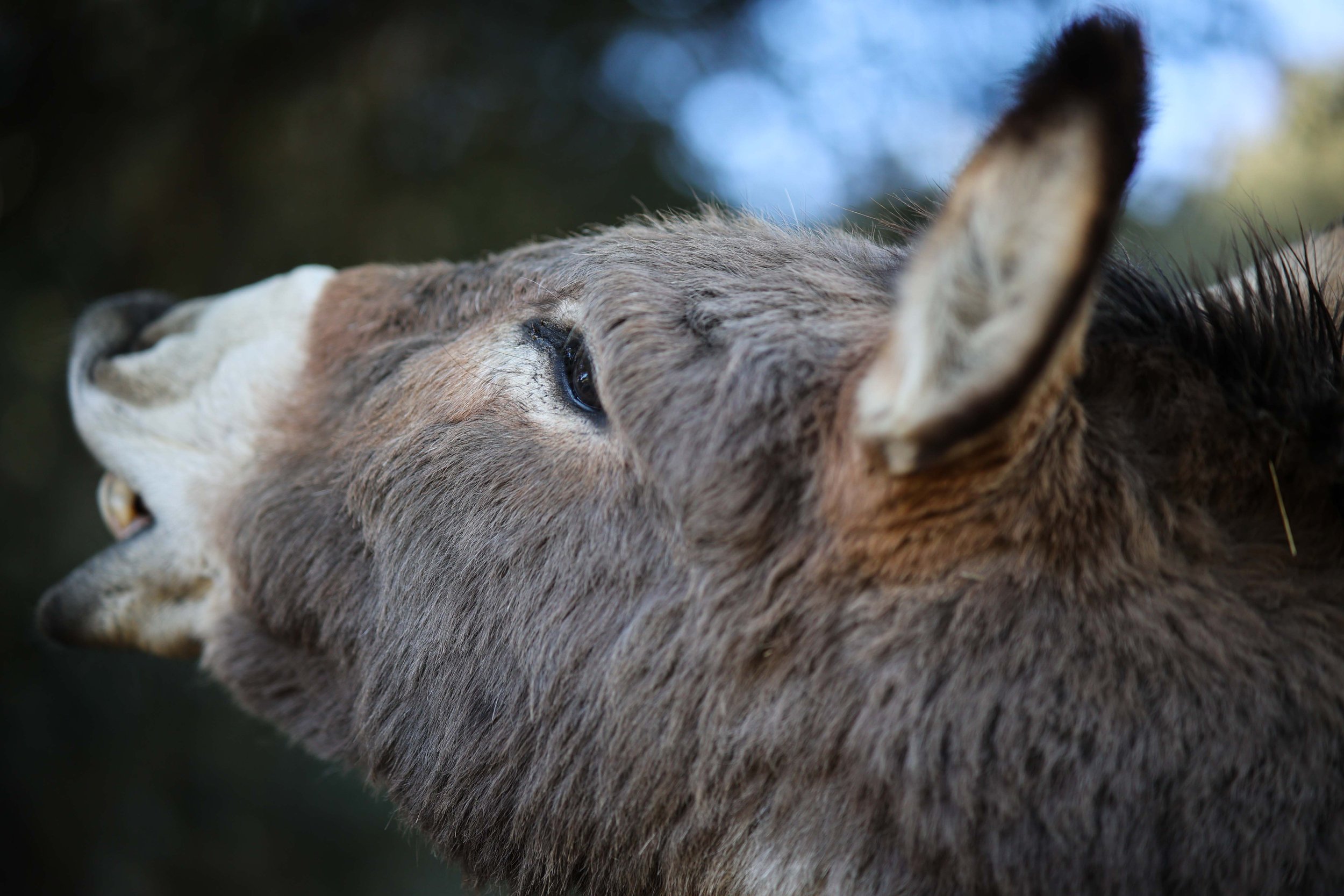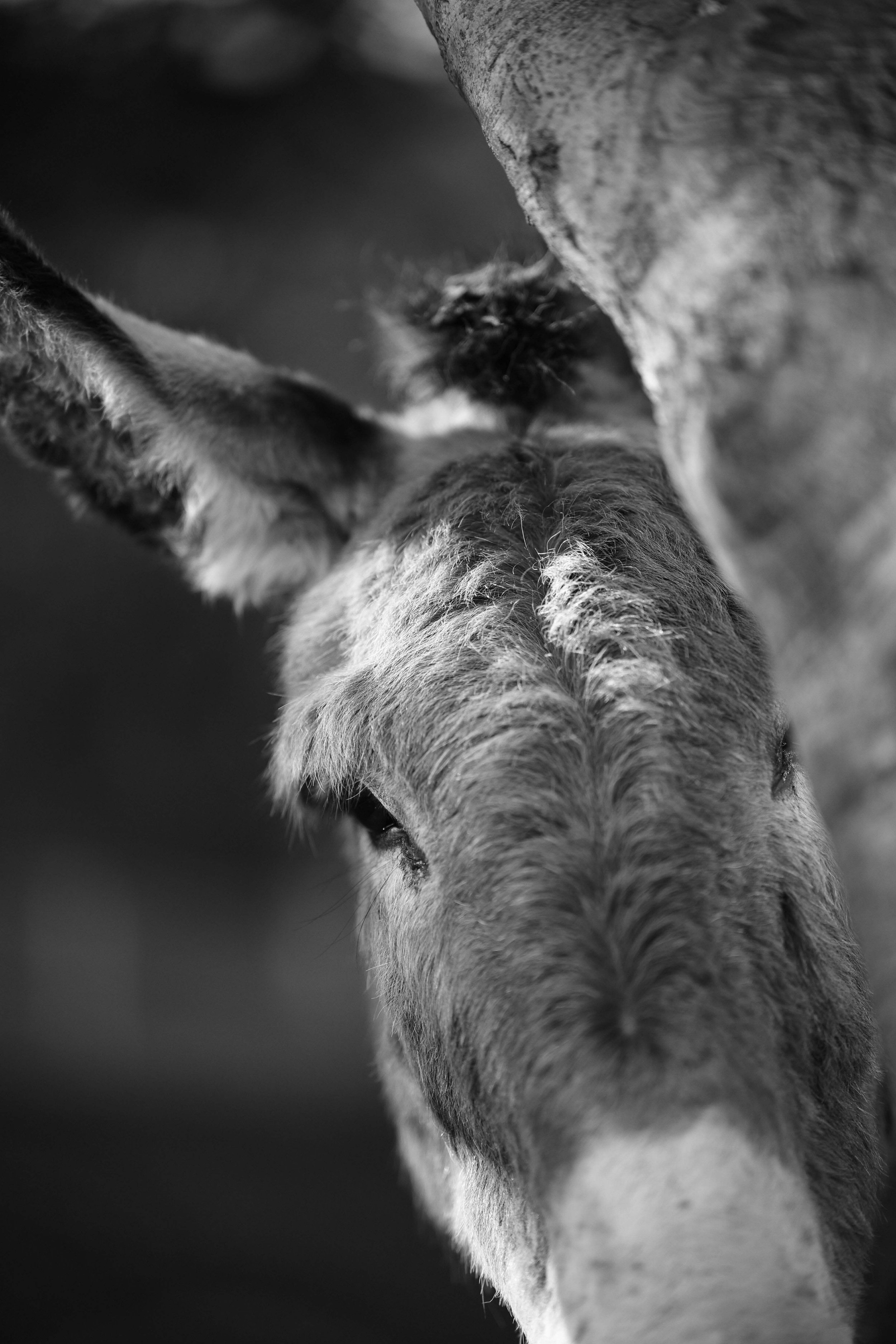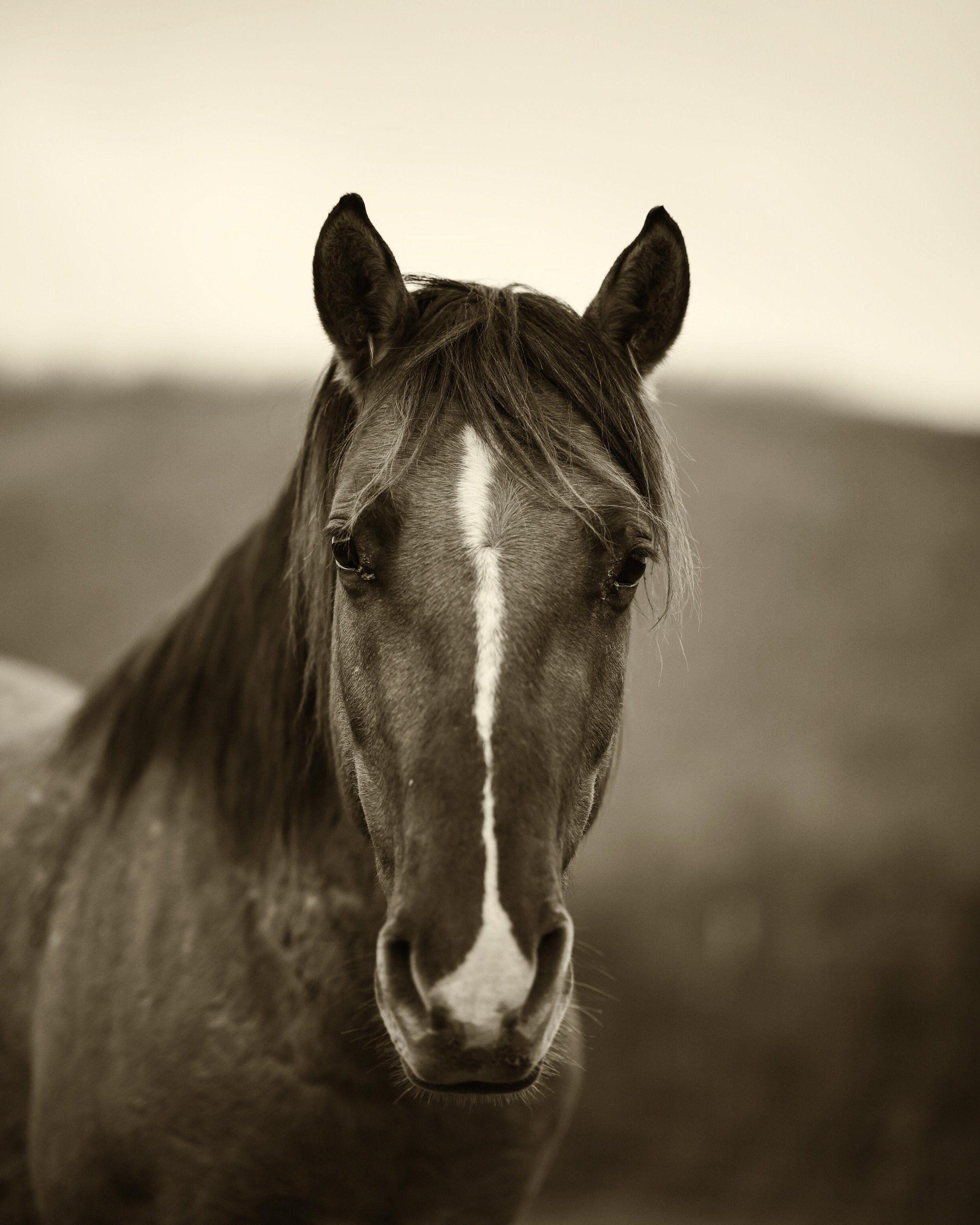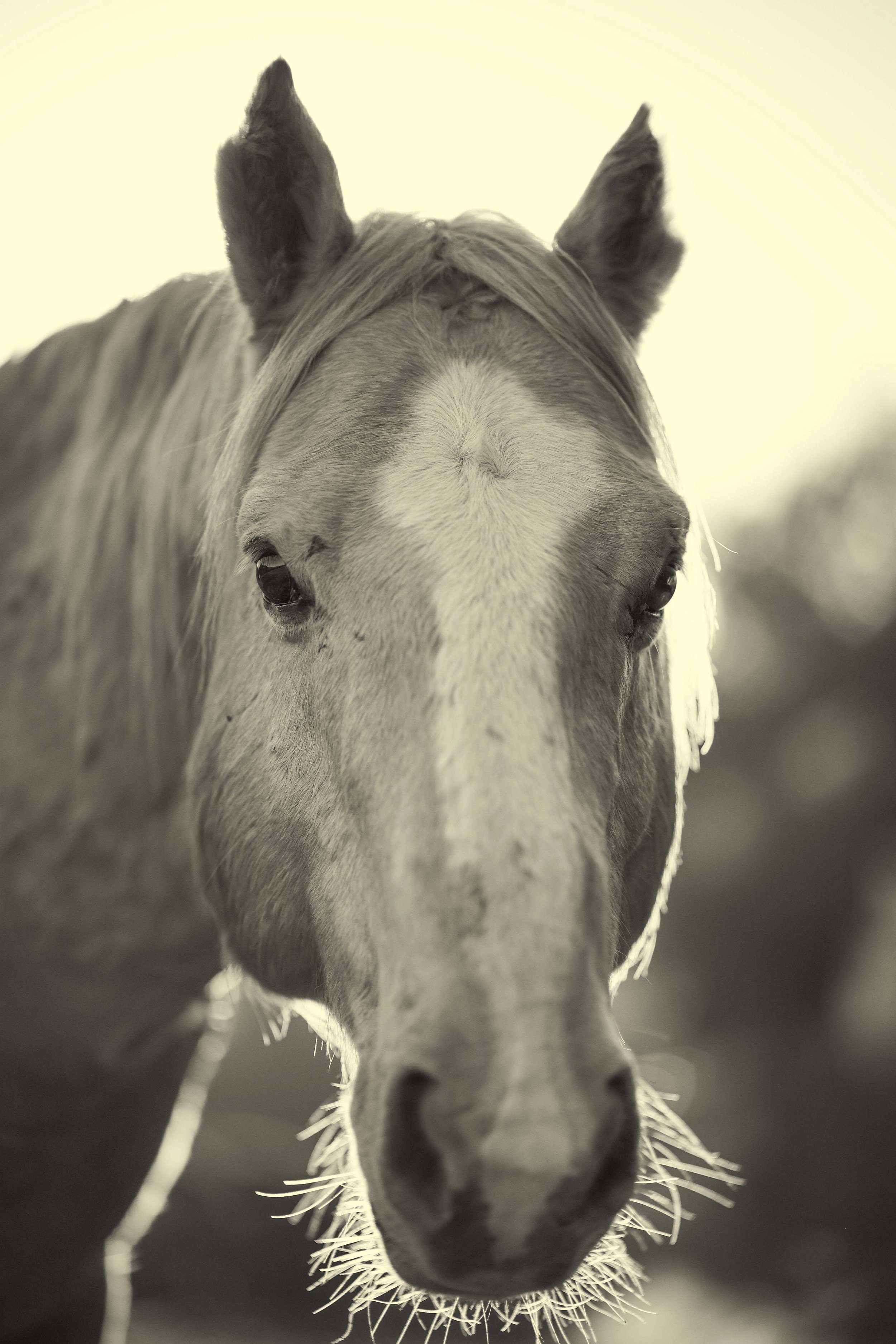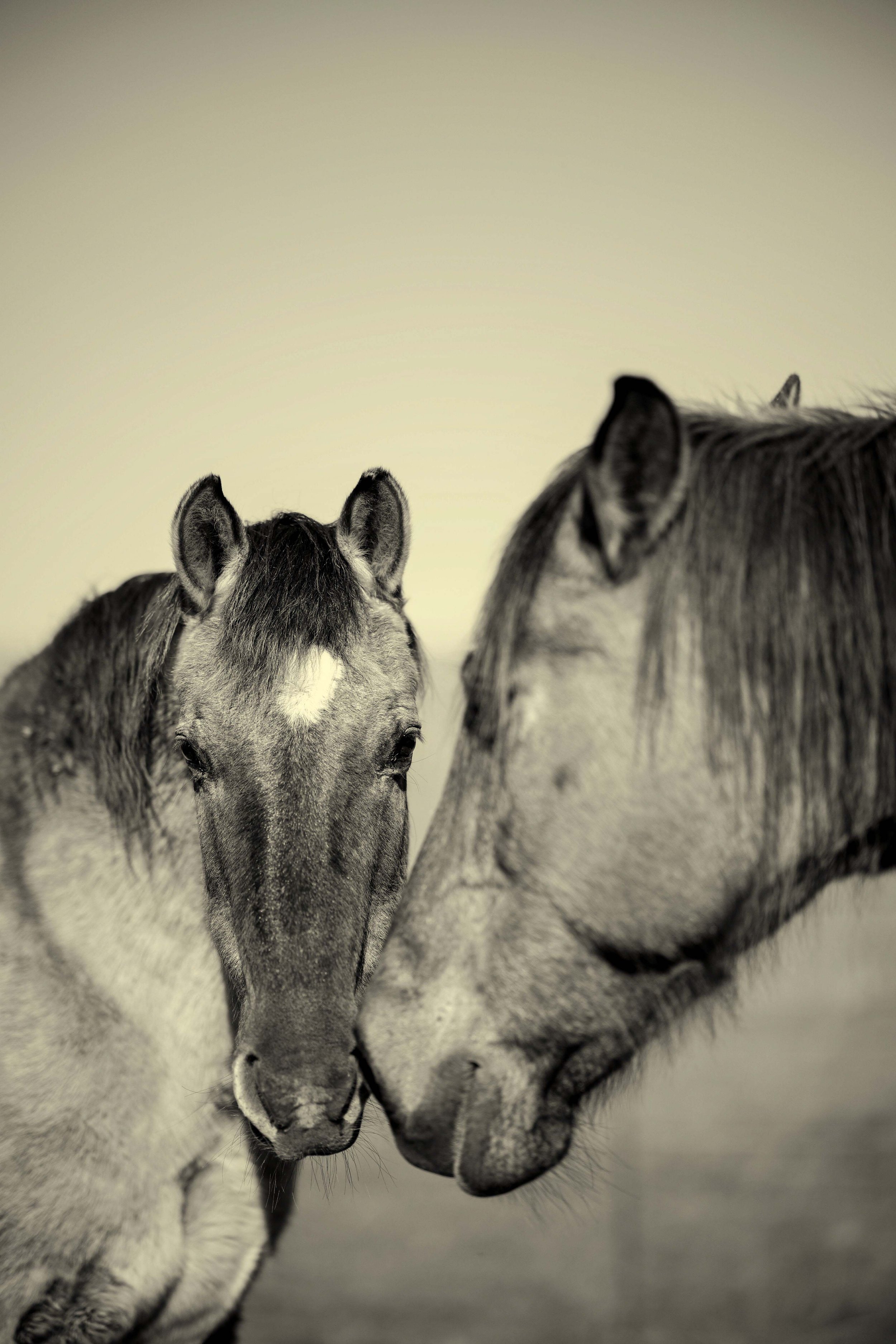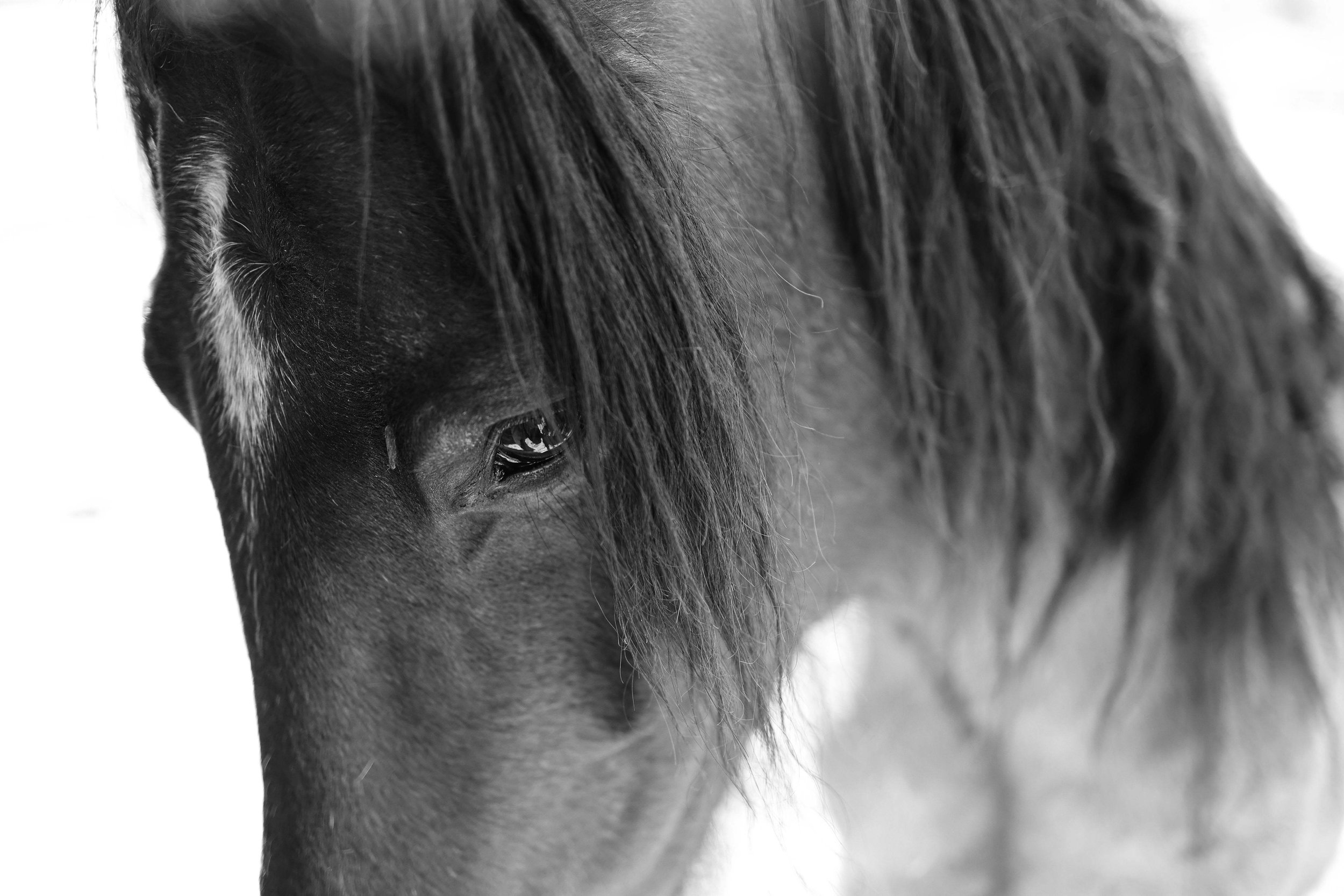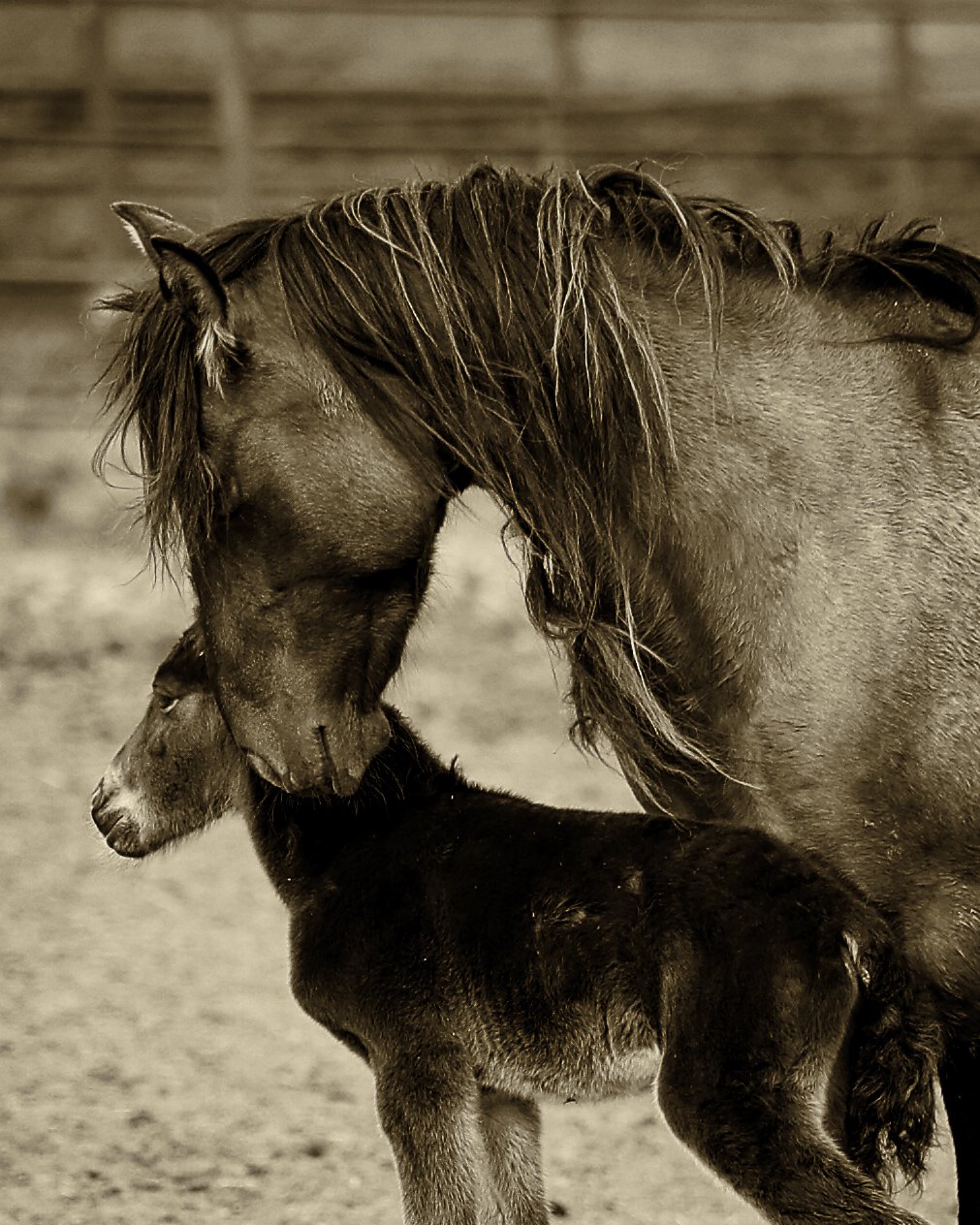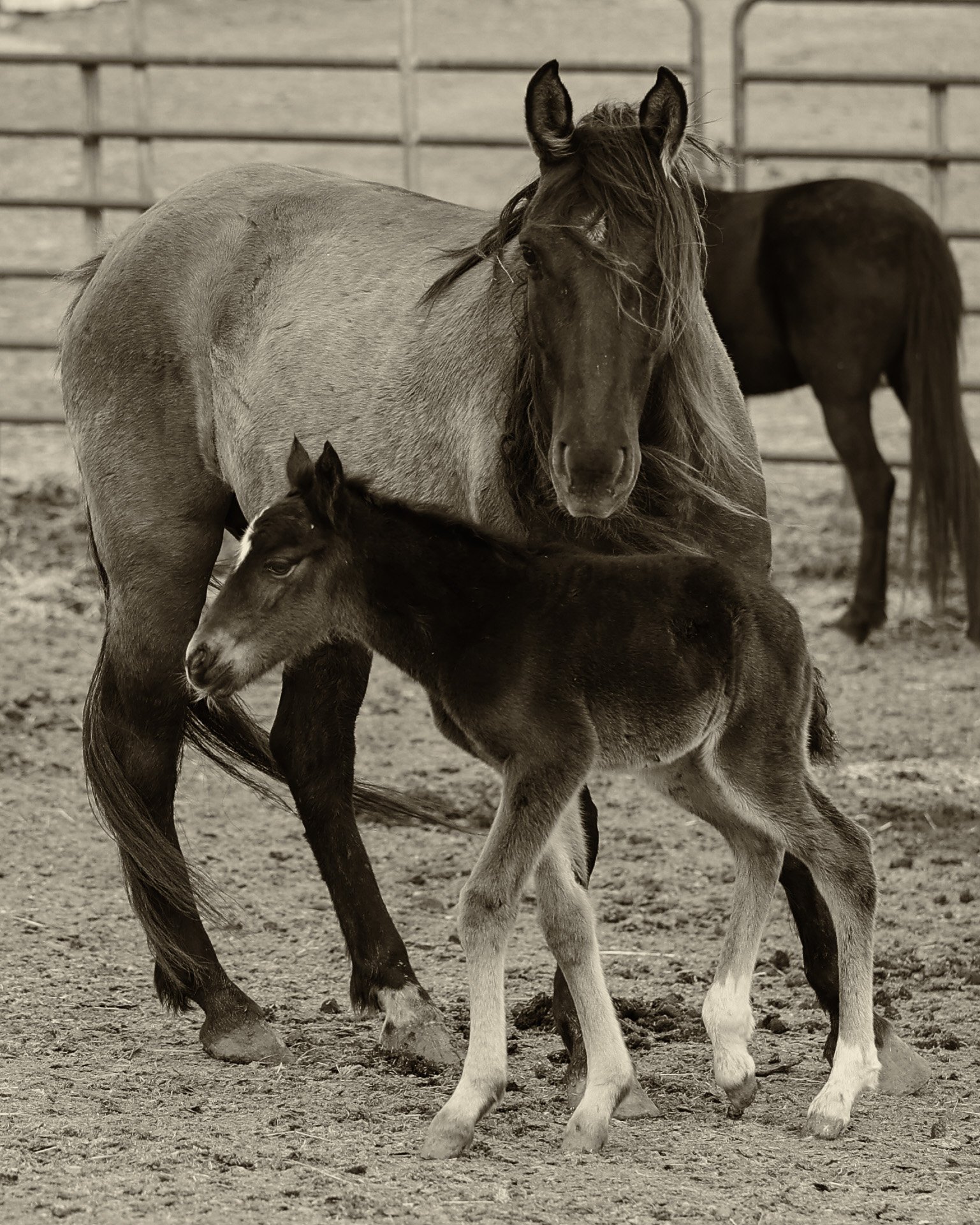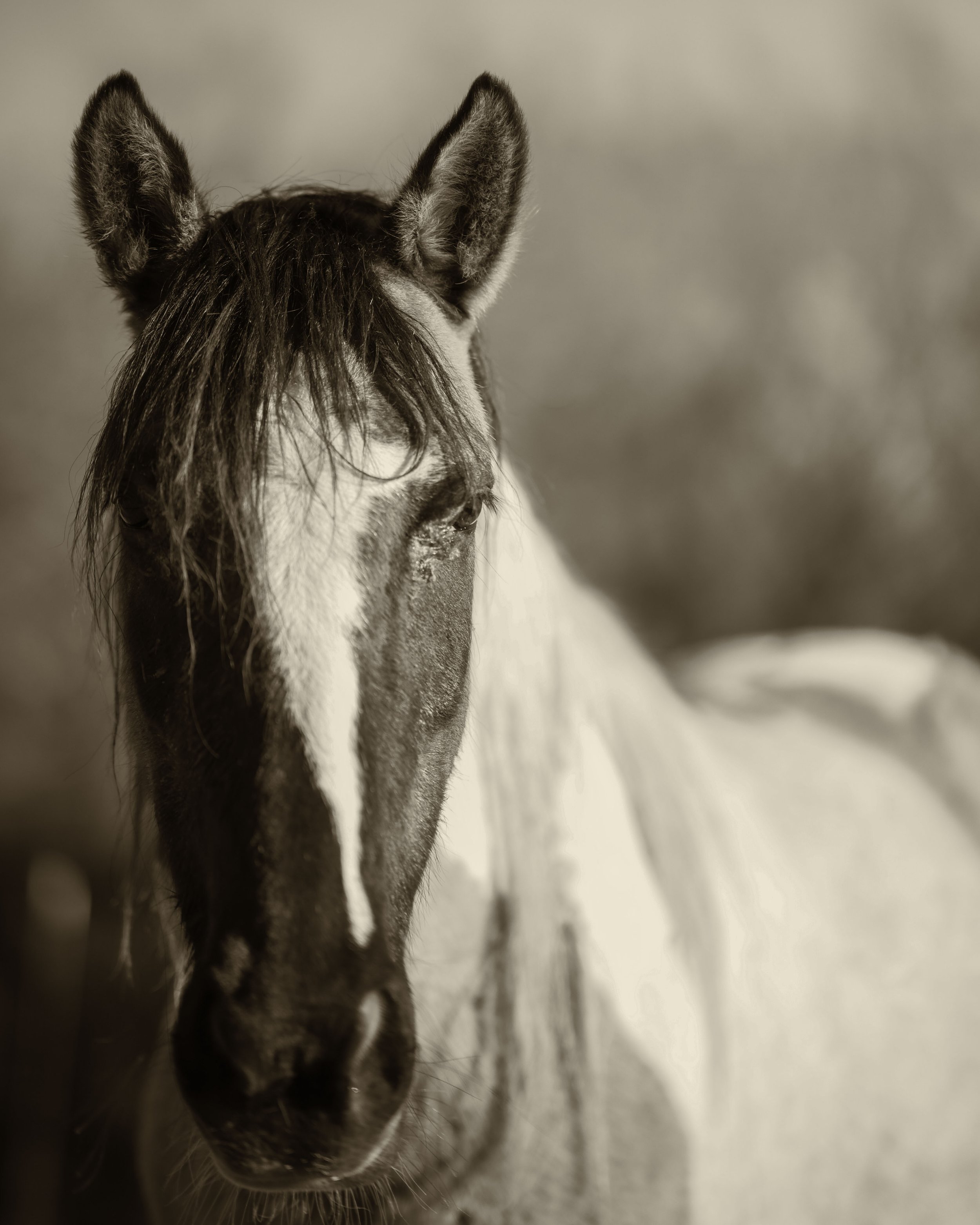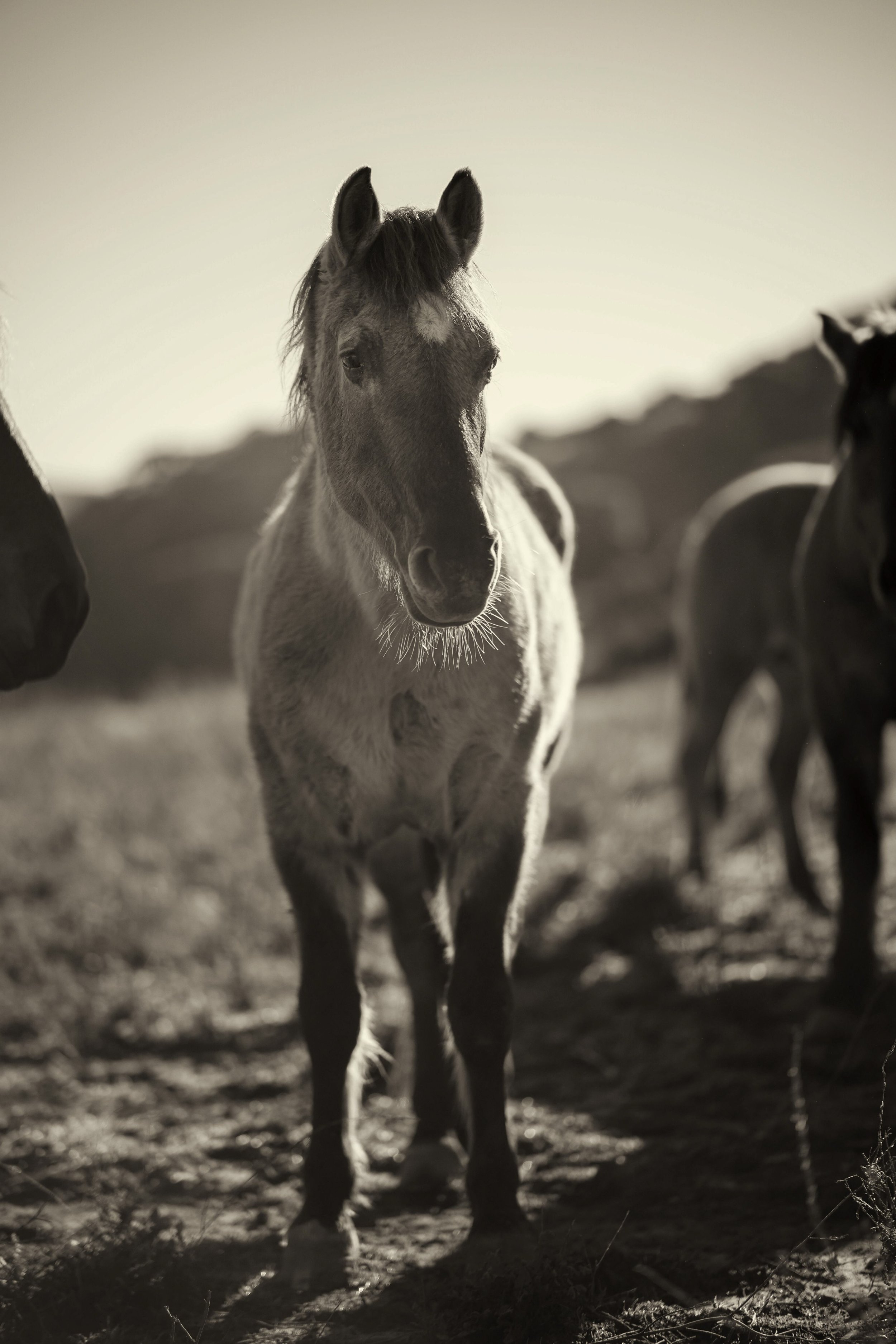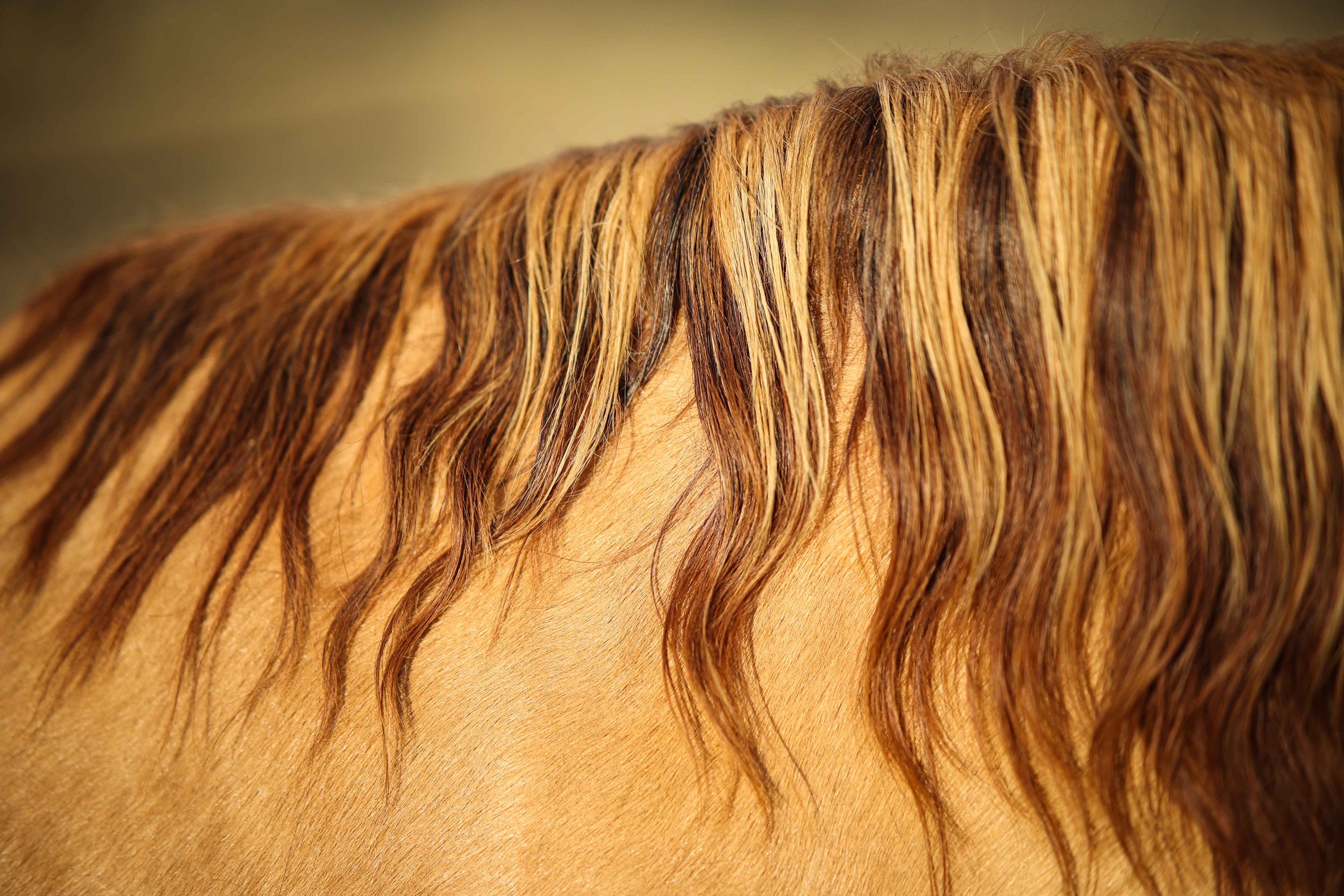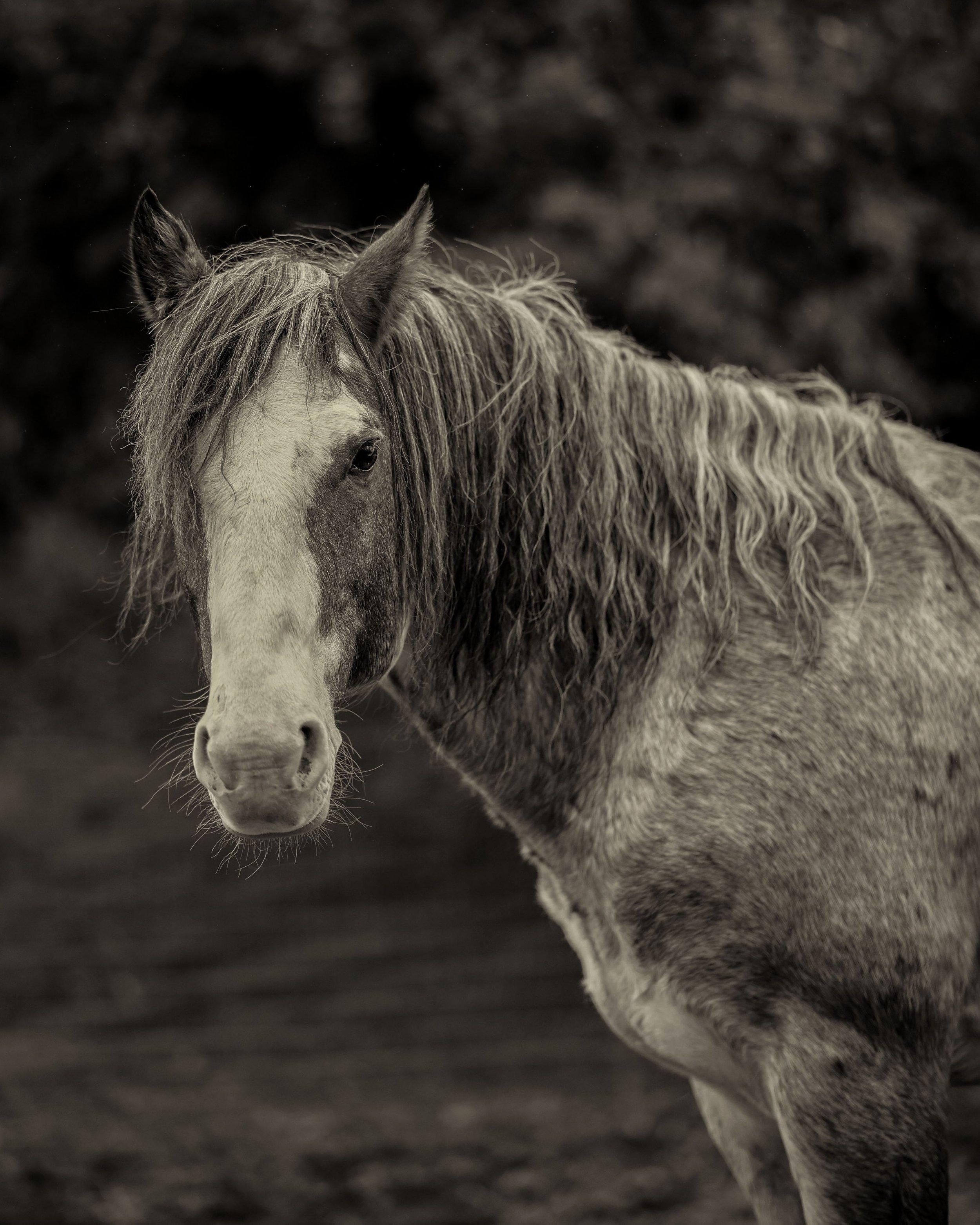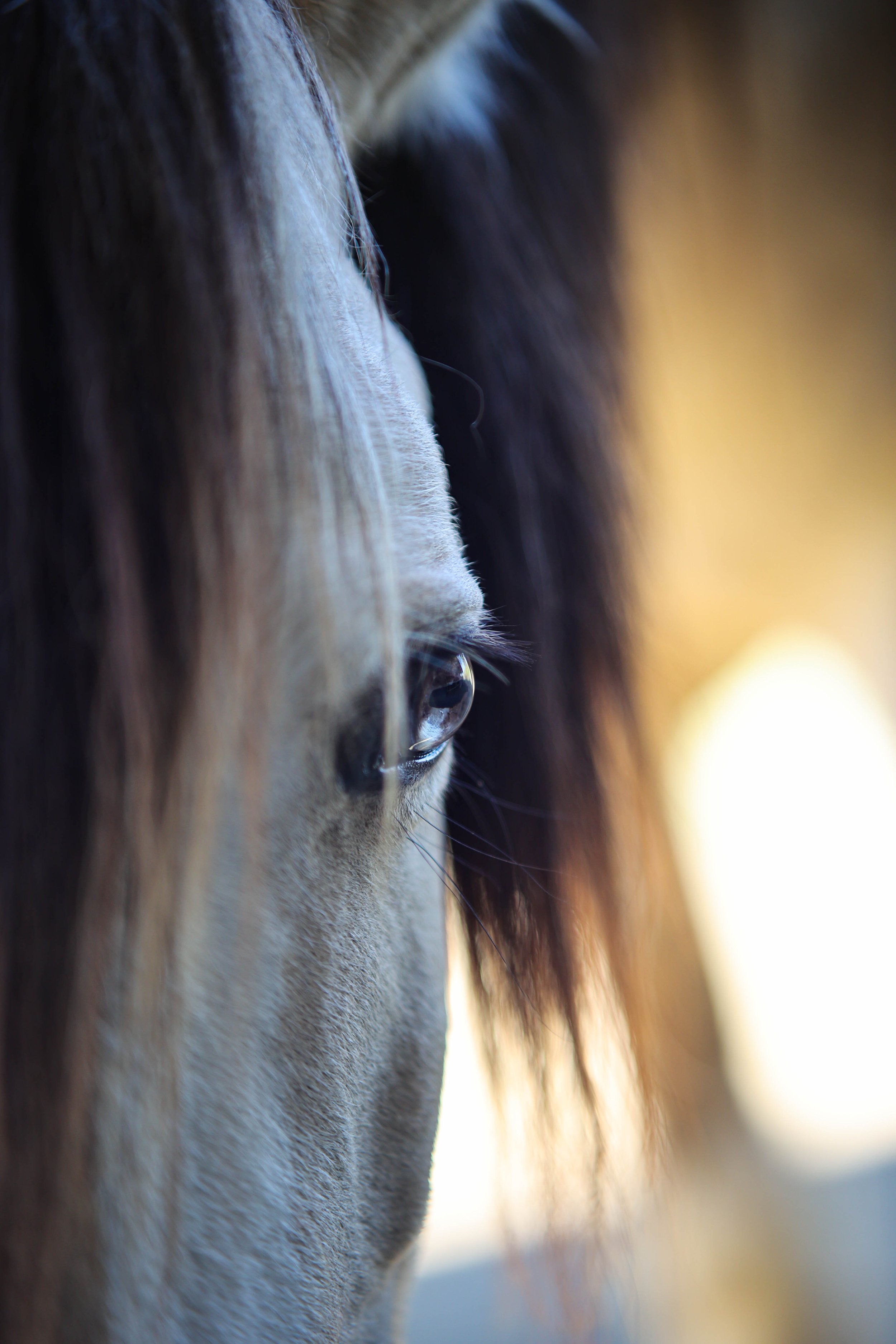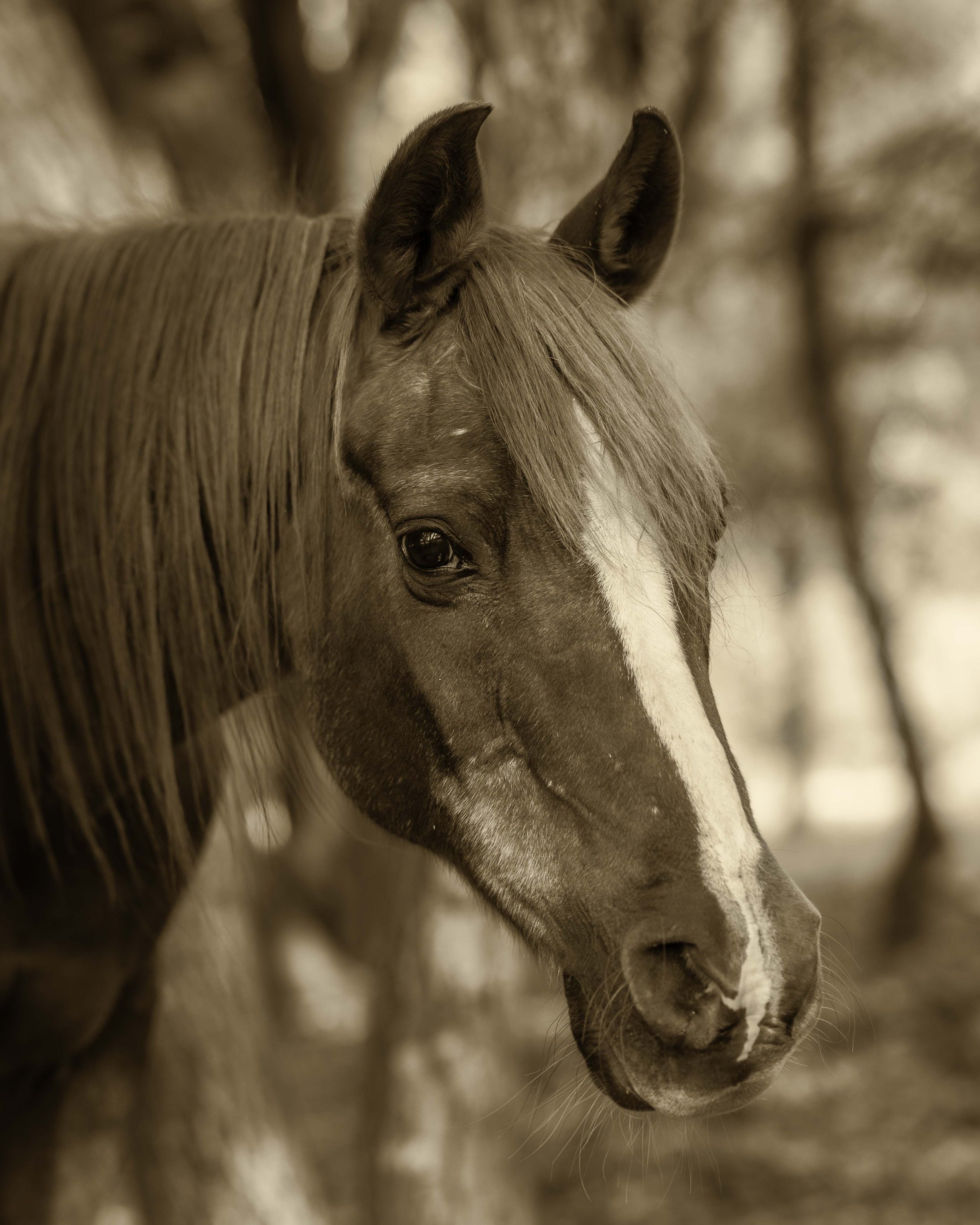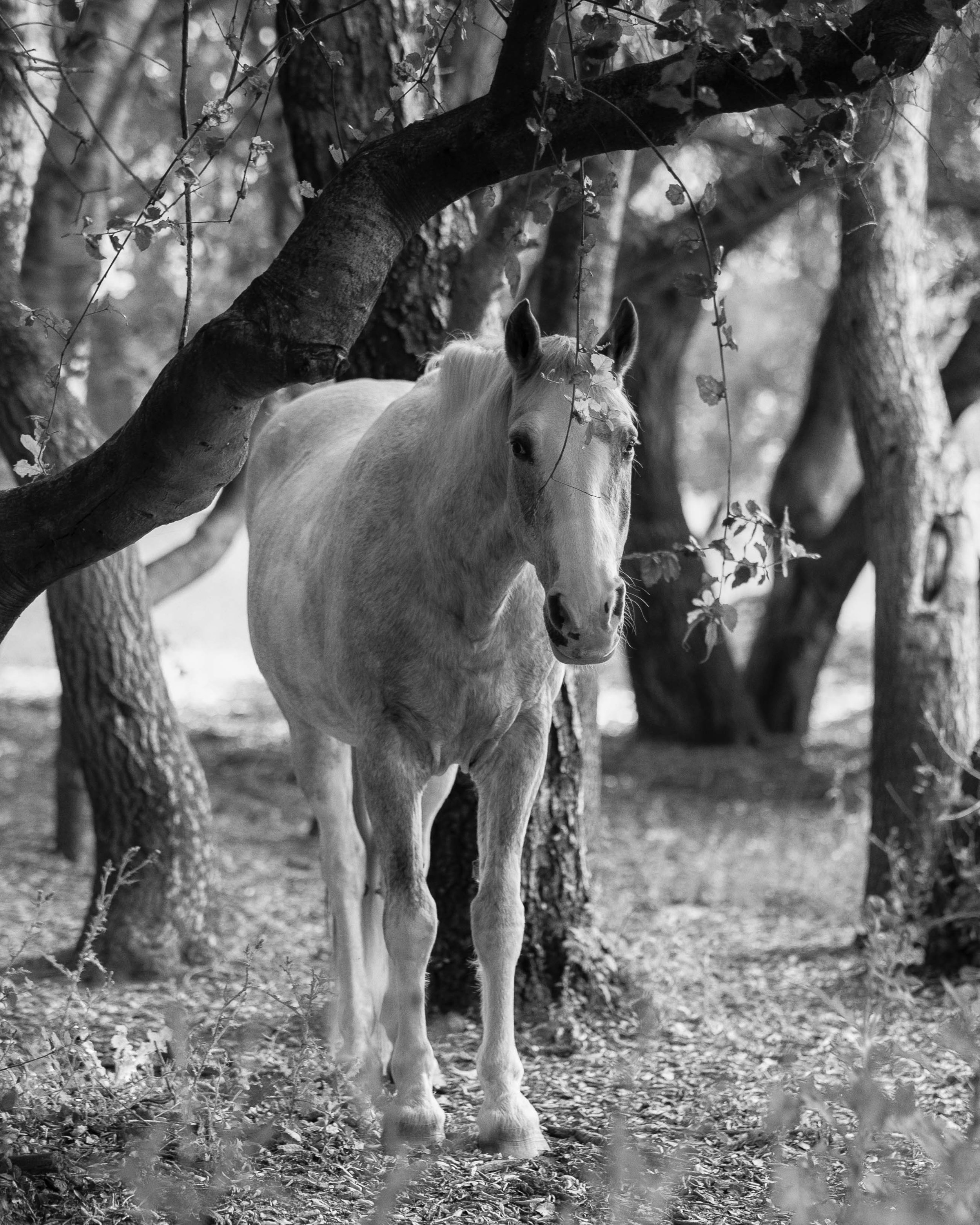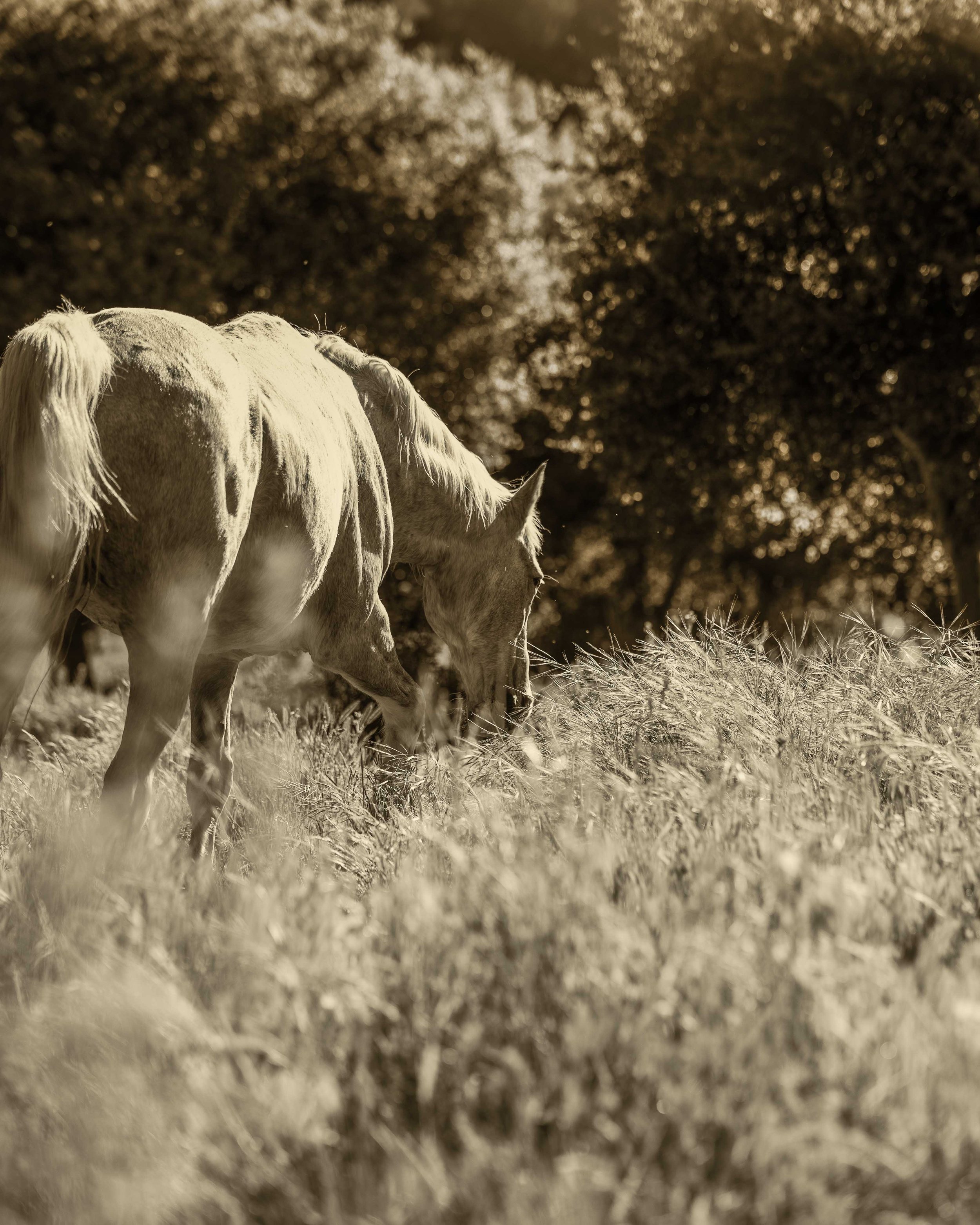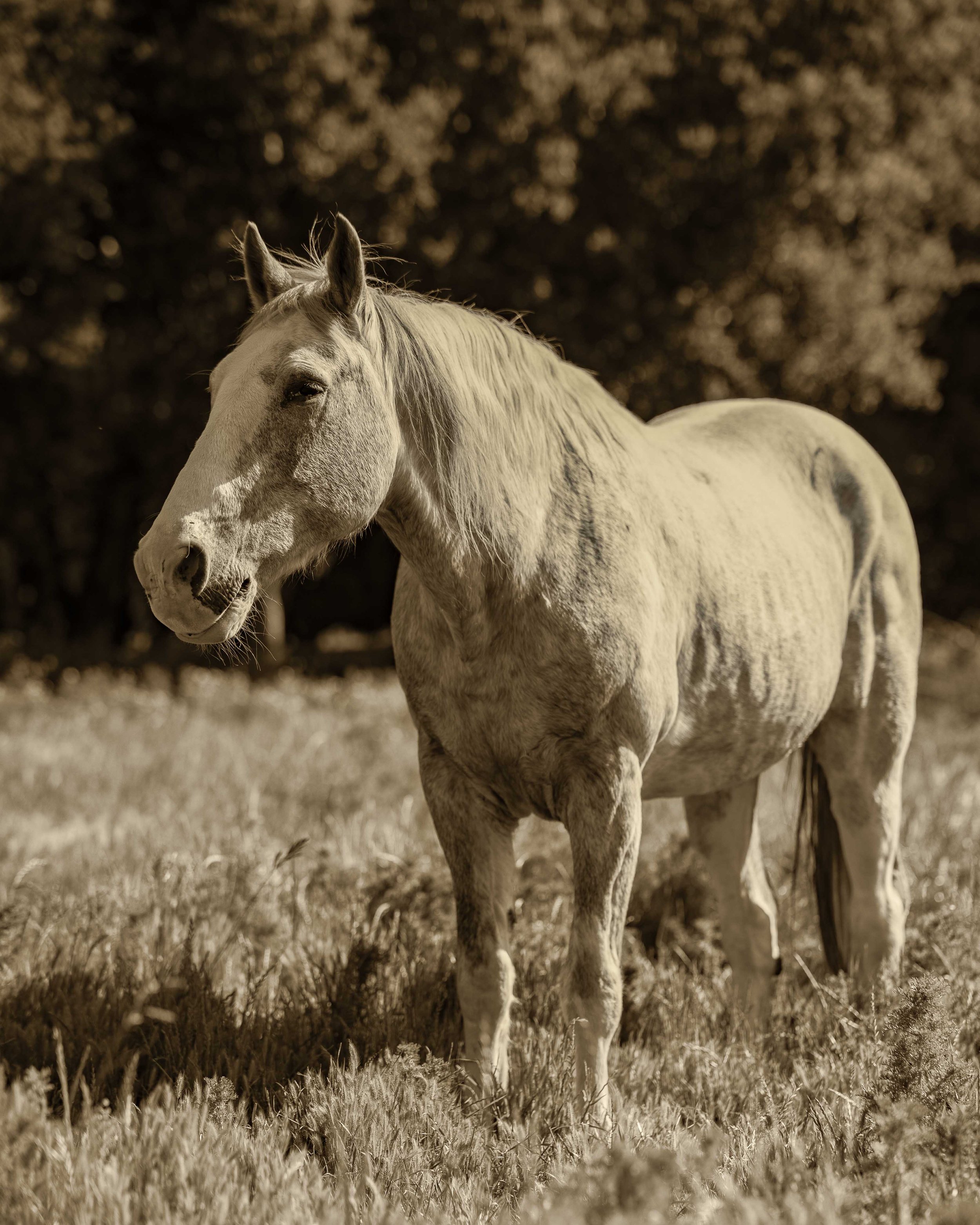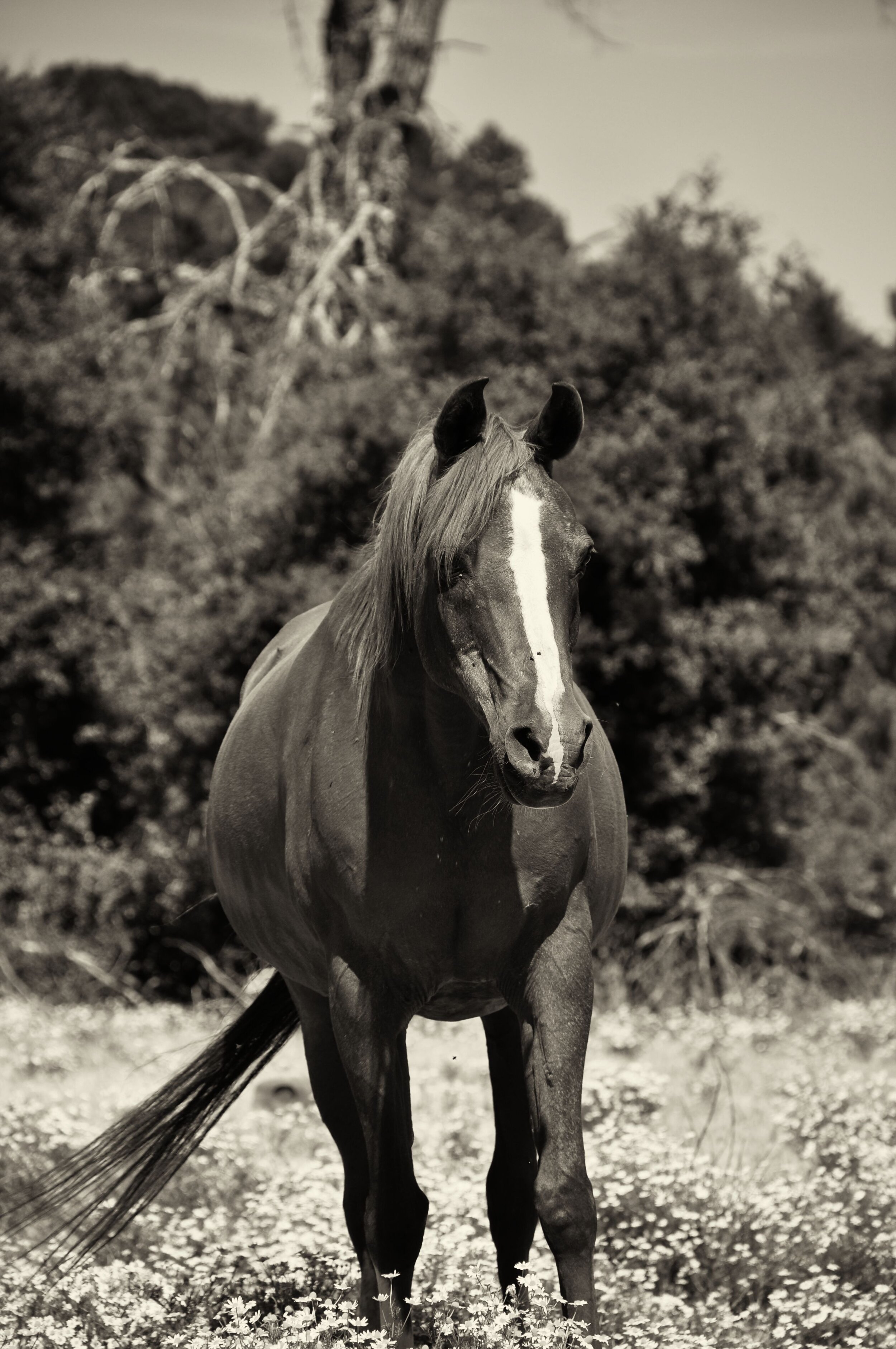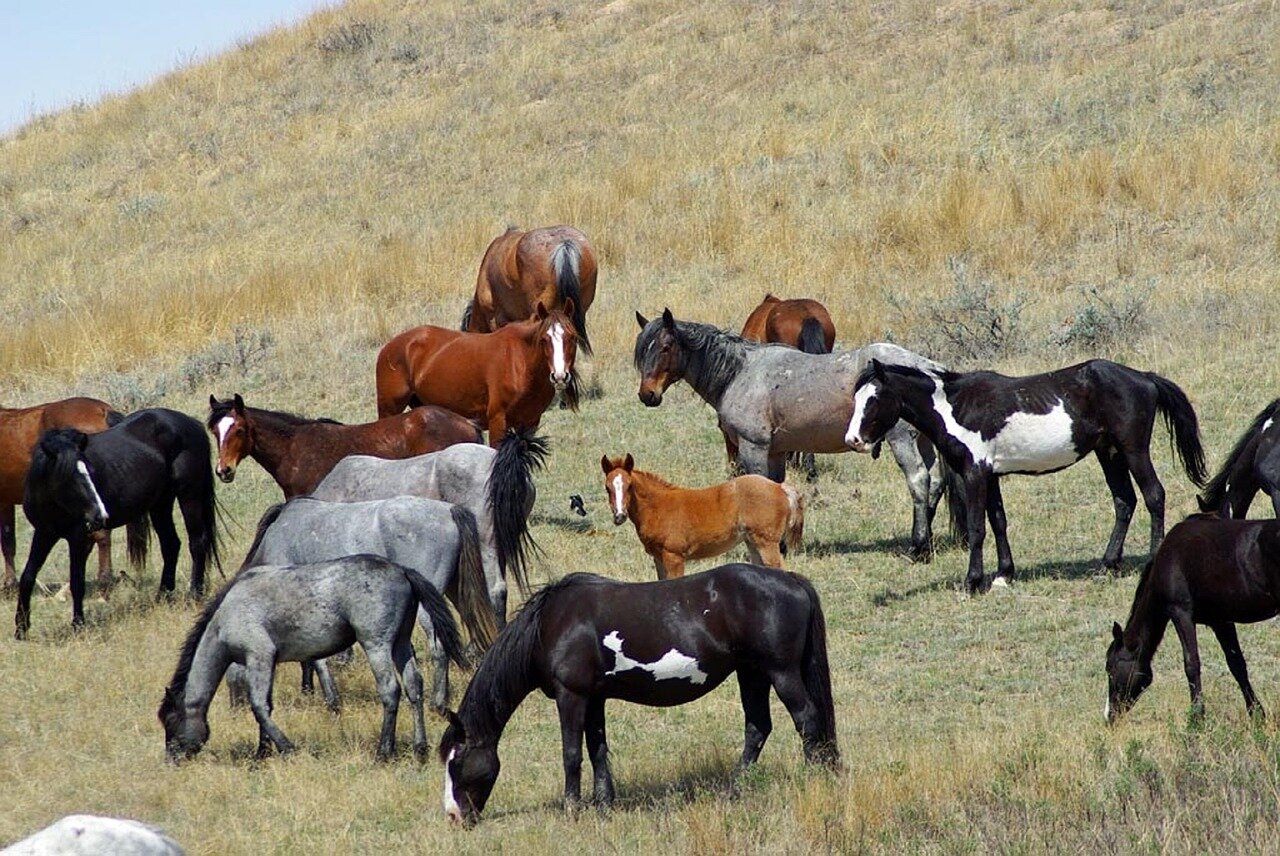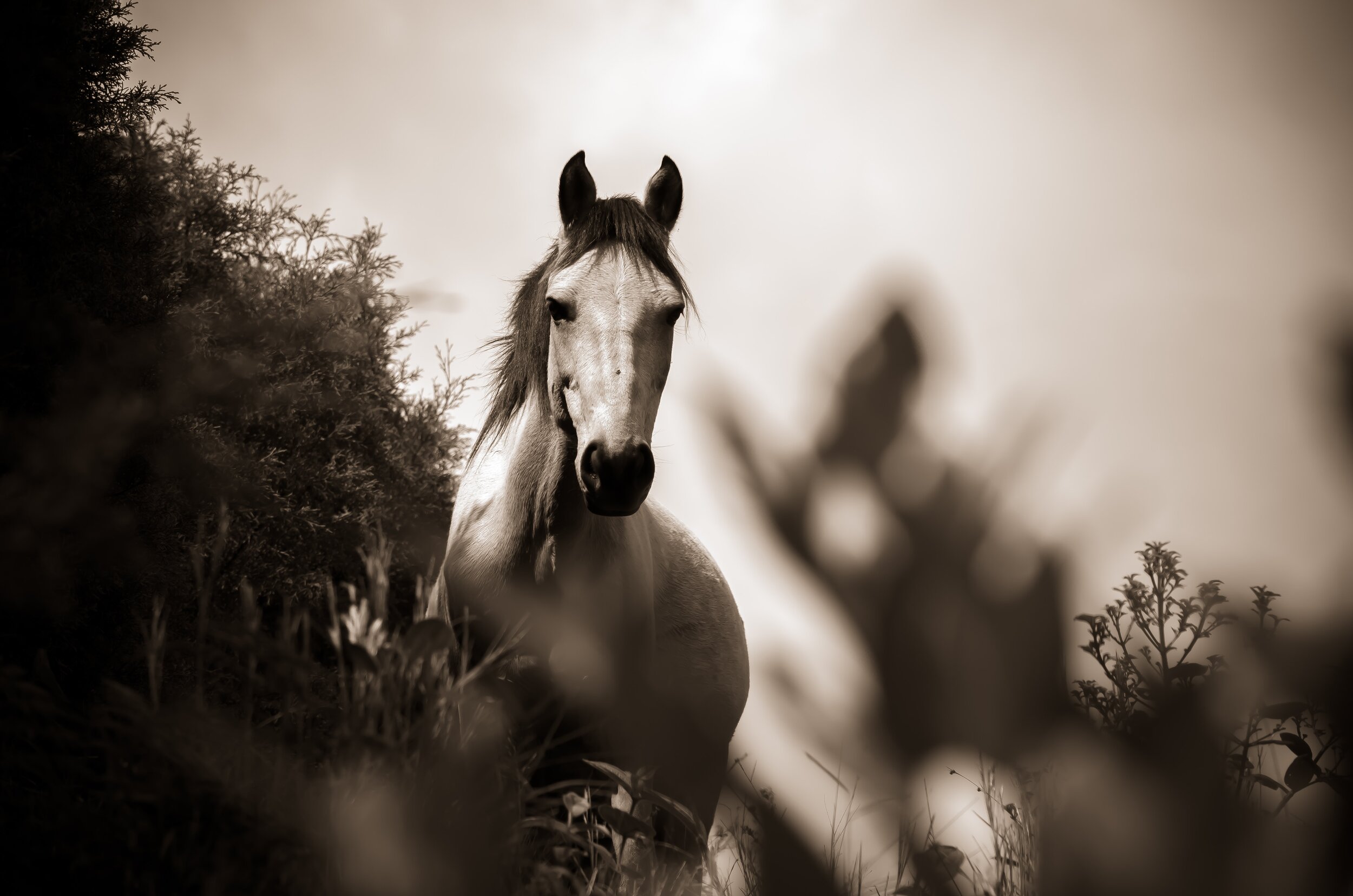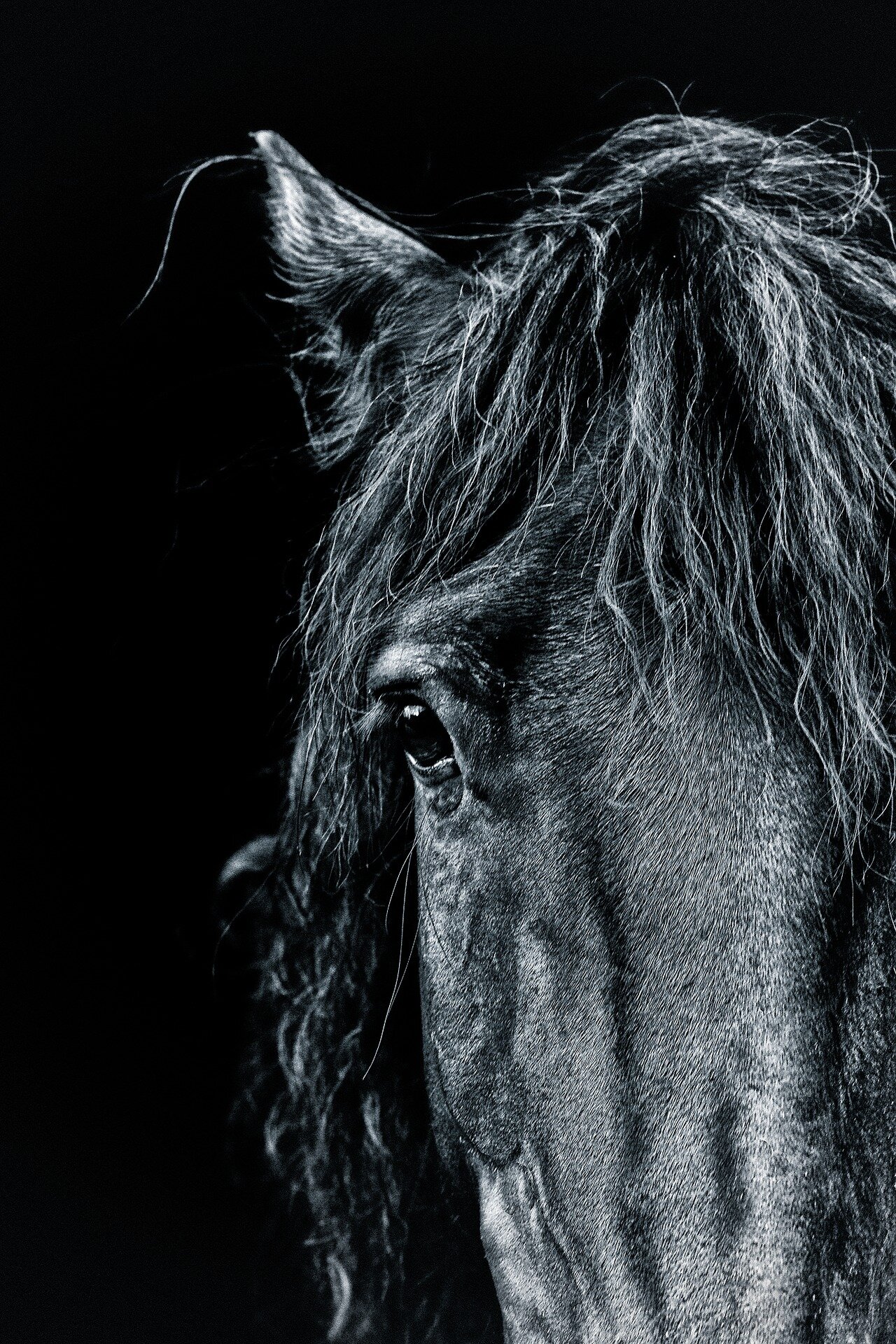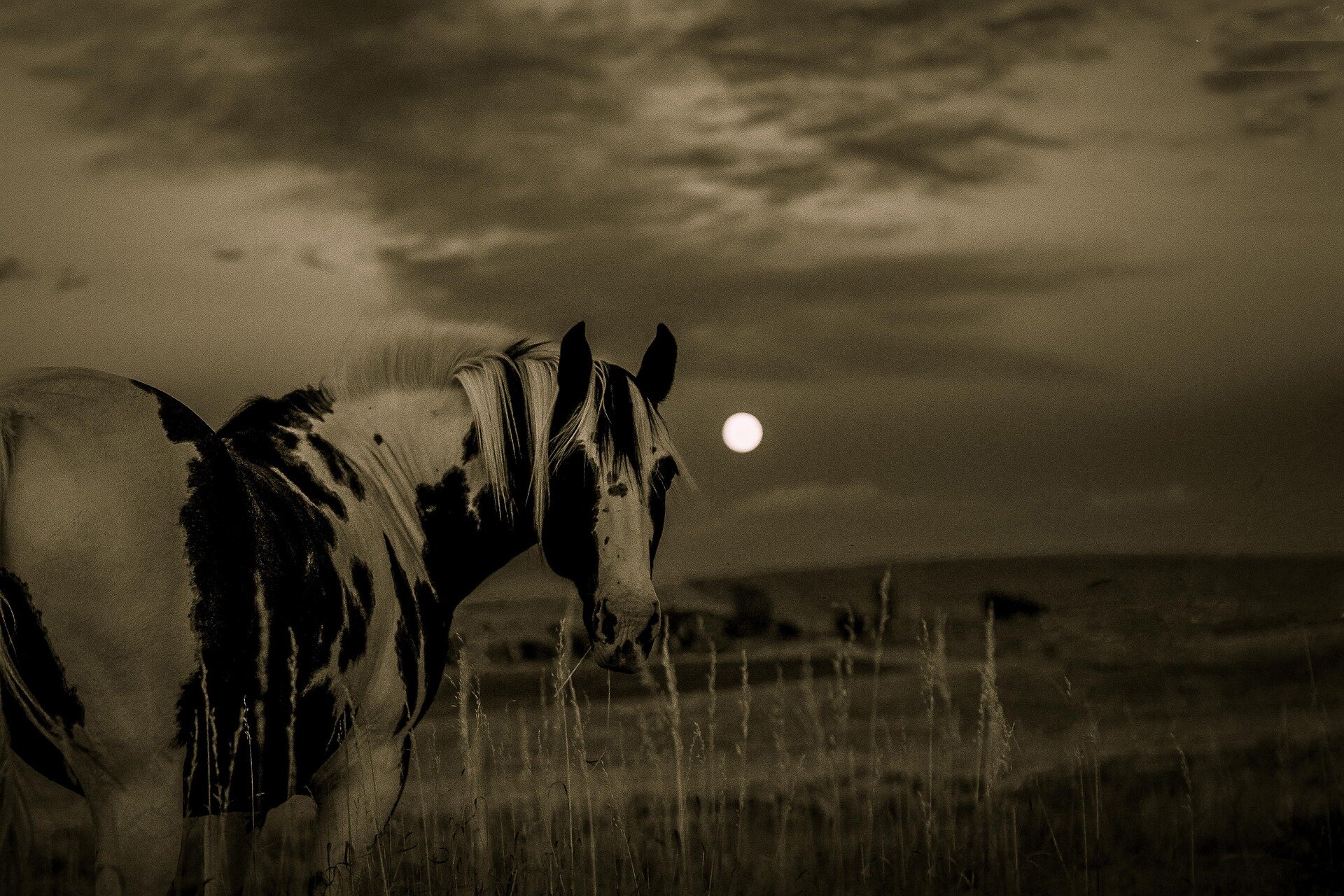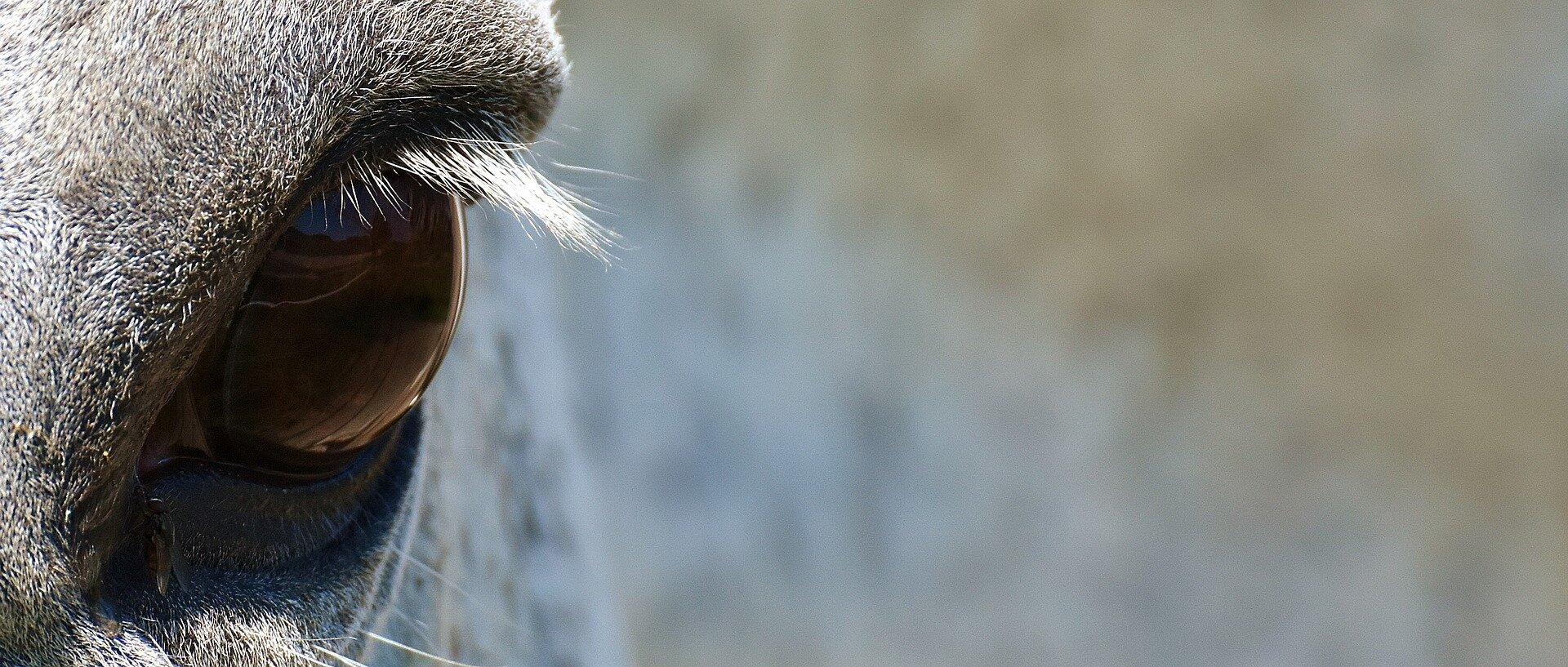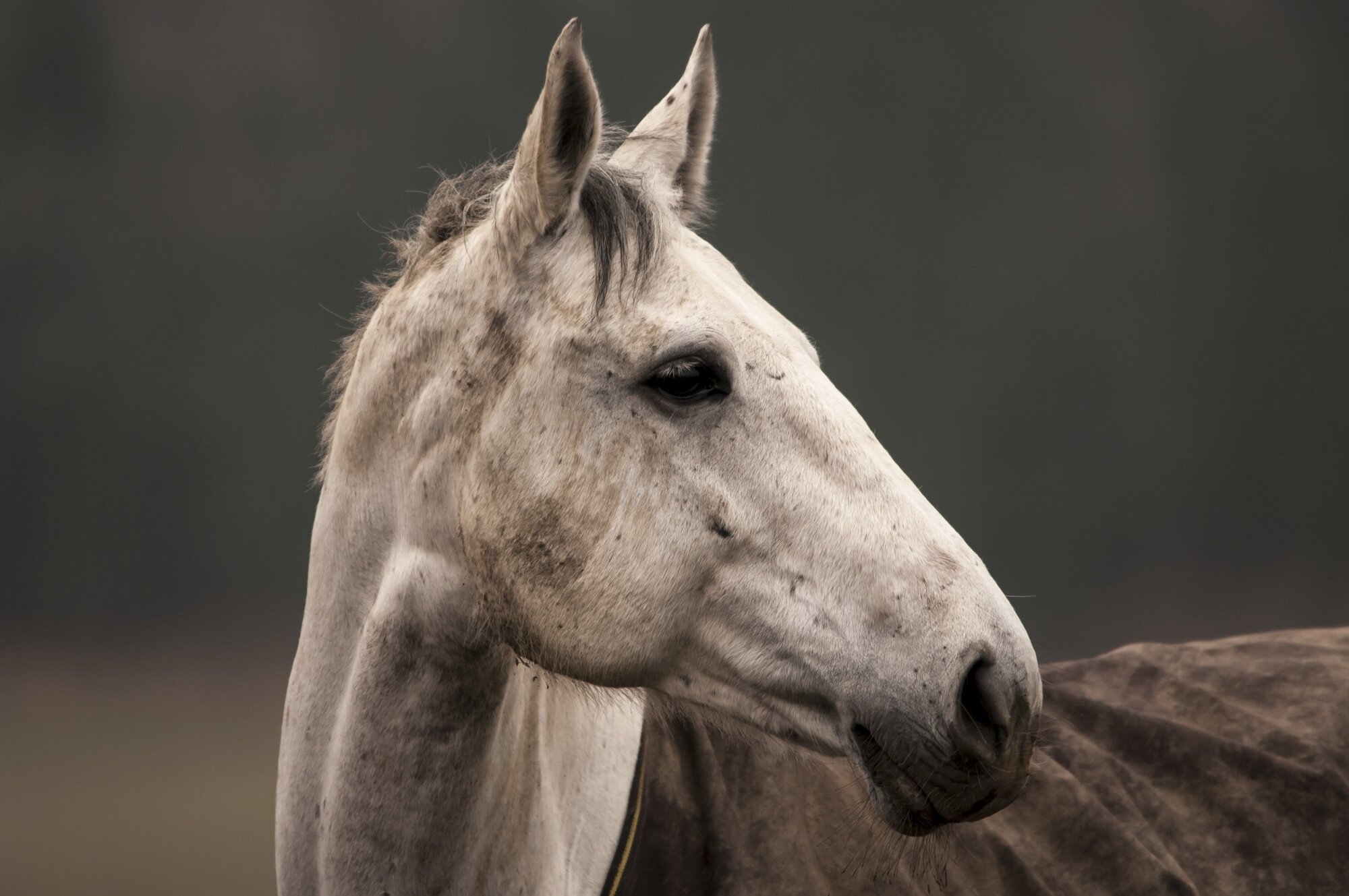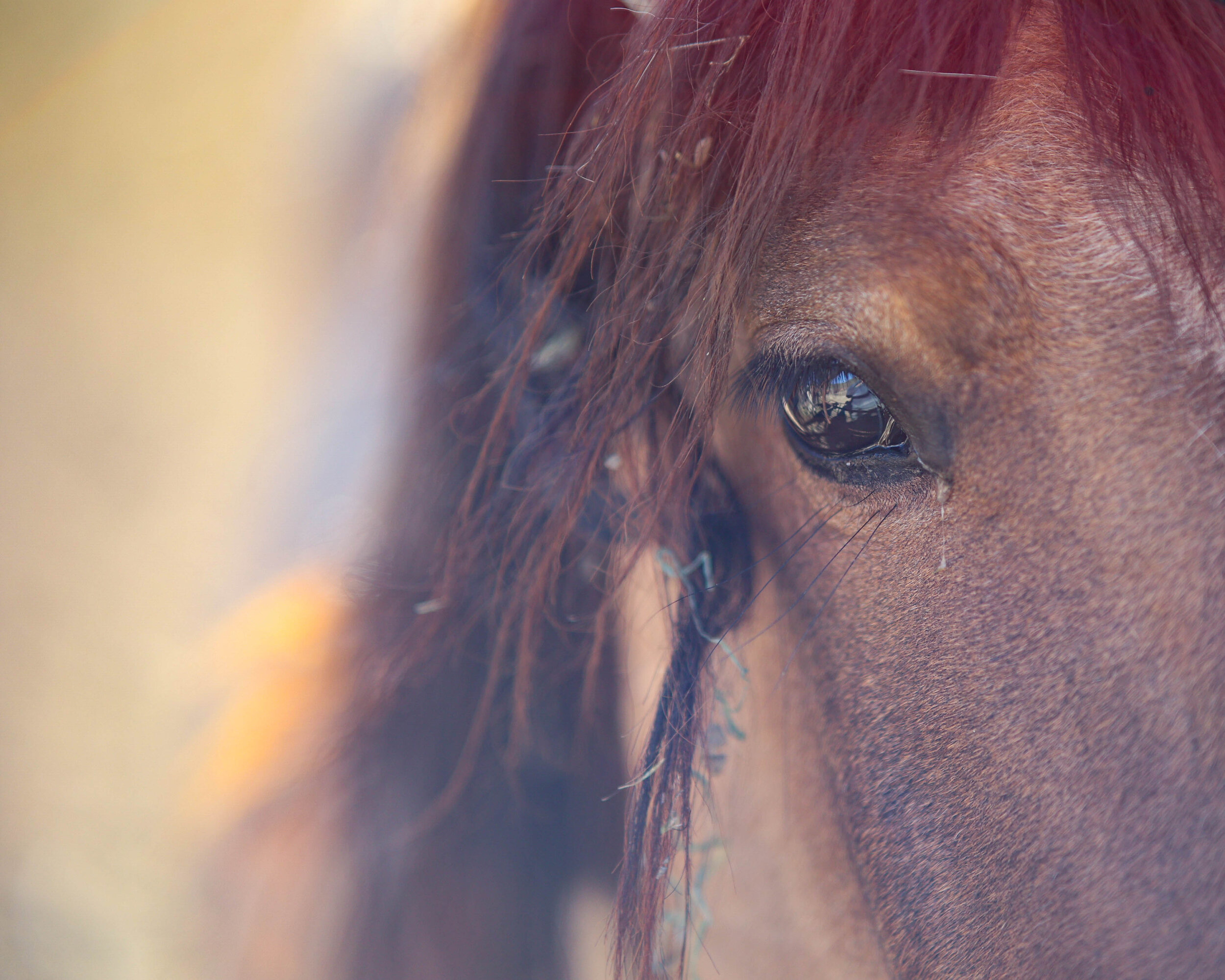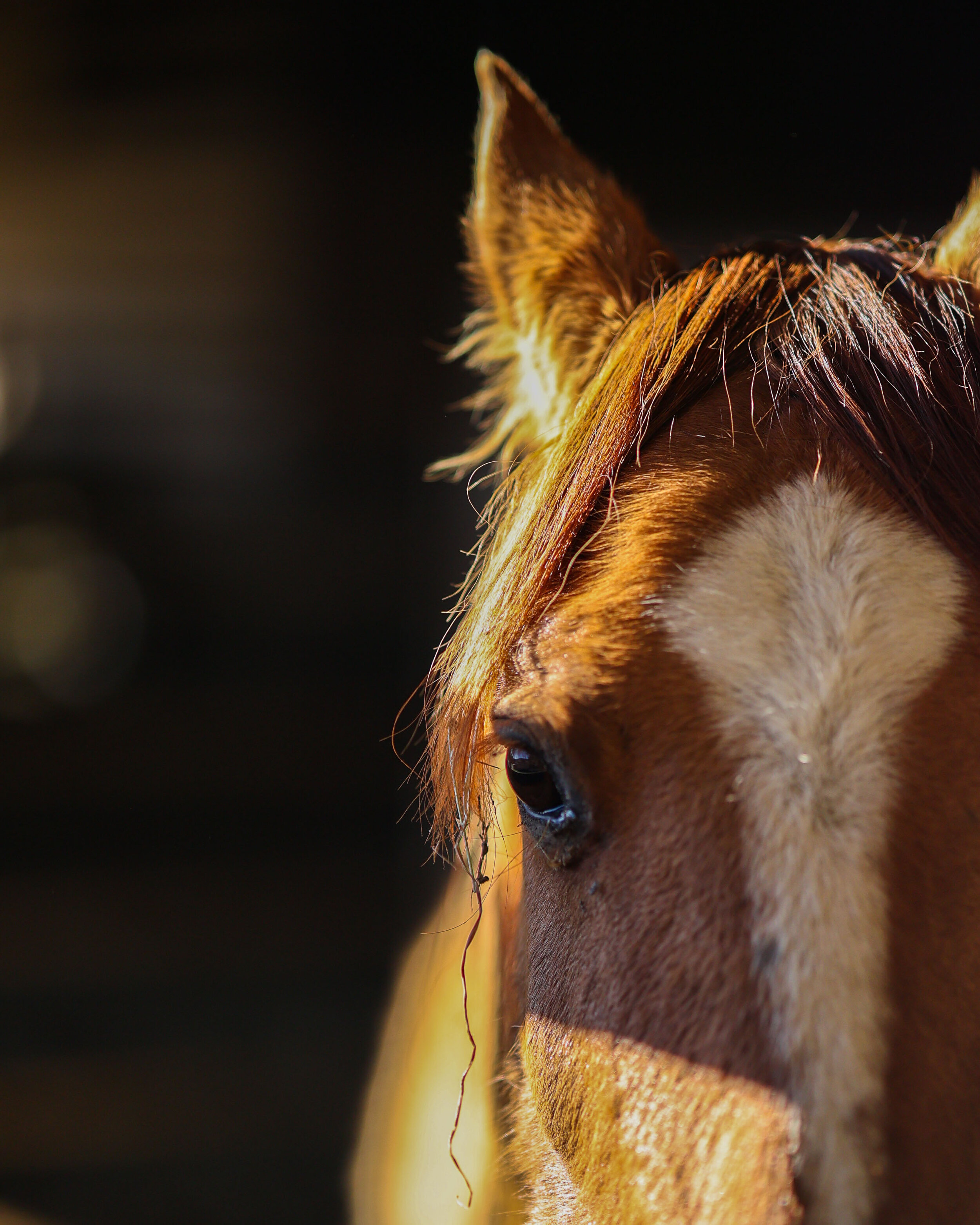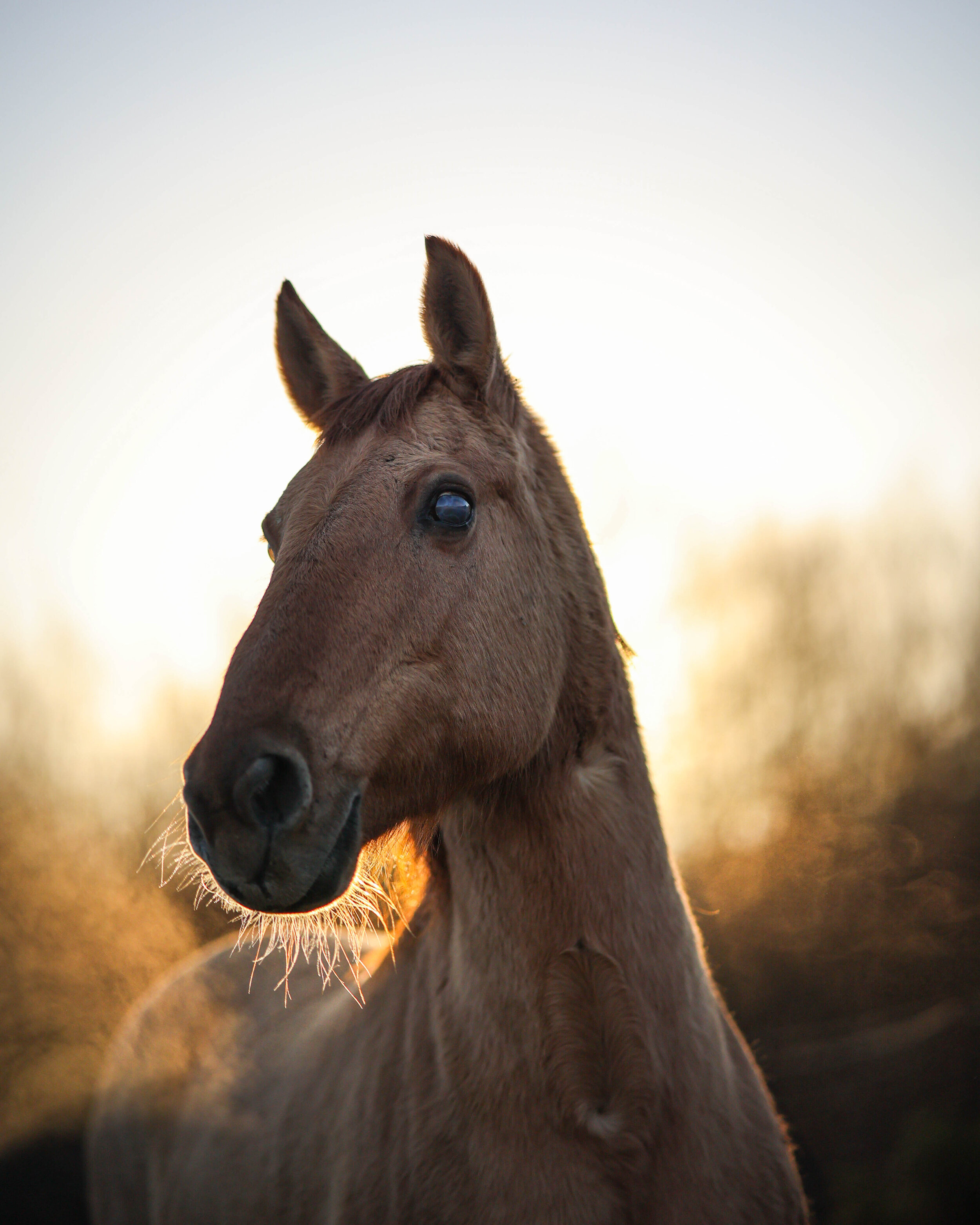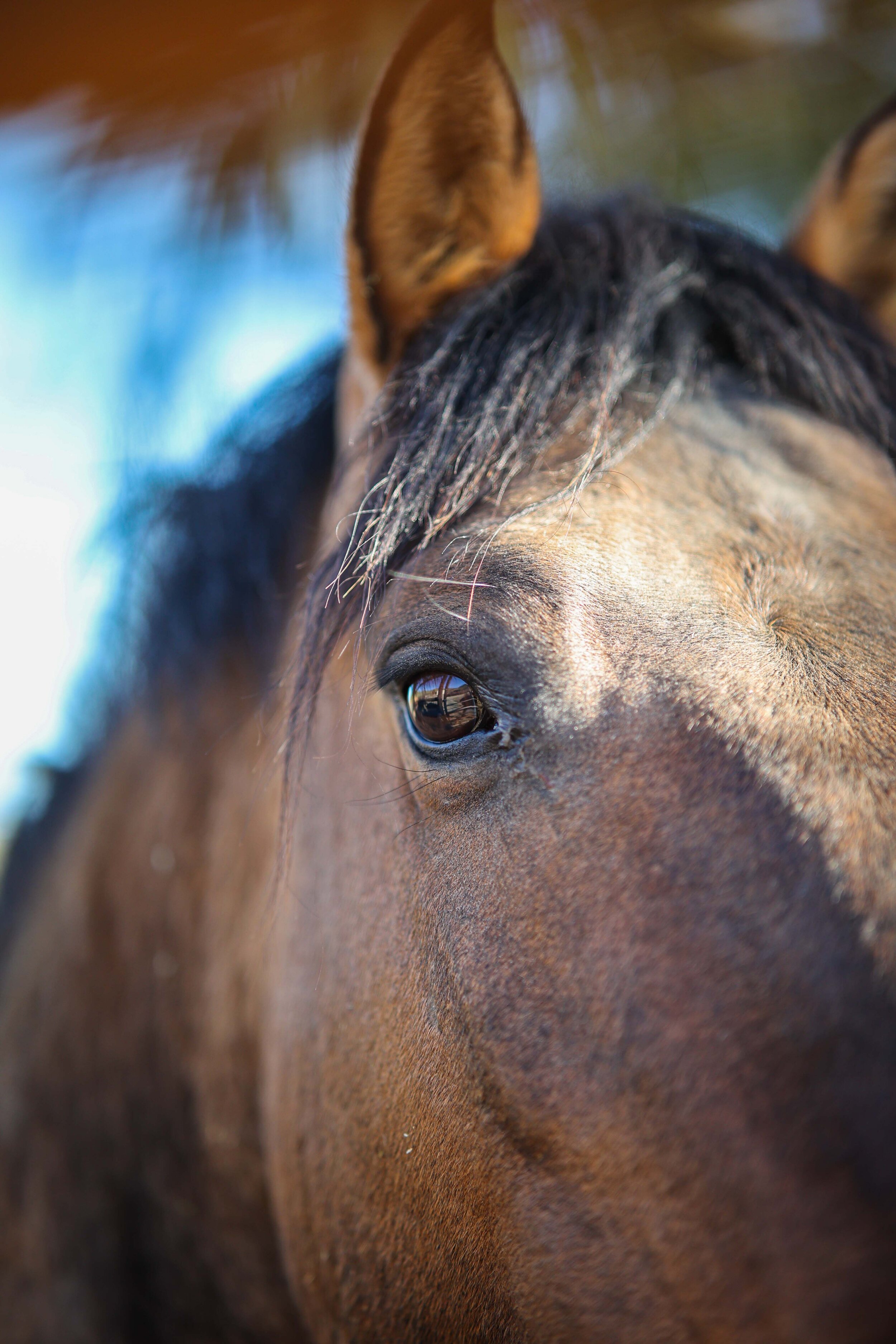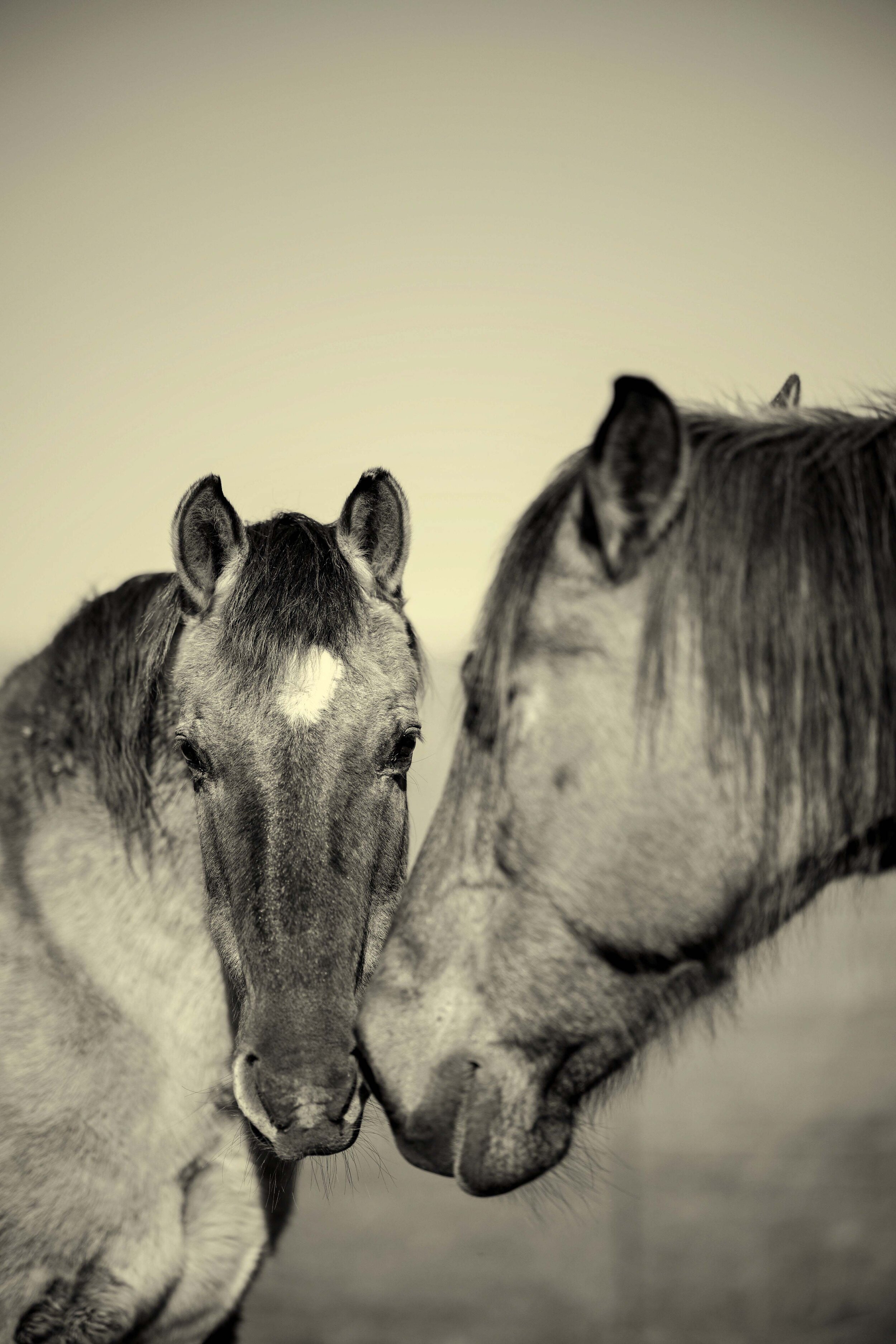
The Magic, Medicine, and Mystery of the Horse
Click Here for Portraits of Equine Sages.
If the horse is a kind of emissary from nature, or even an emissary from the great mystery of life (the divine, the sacred, whatever we may call it), then we need the sort of special training the wisdom traditions of the world have bequeathed to us in order to attune ourselves more skillfully to what horses can teach us. We can only learn from them as much as we make ourselves ready for.
The wisdom traditions of the world can empower us to receive the fuller potential horses offer us, and we can find these teachings nowhere else—not in any horse clinic, not from any horse trainer, not in any horse books, not in any of our habitual interactions with horses, however skillful we think they are.
Many horse trainers claim to know the horse’s mind, and their ability to get horses to do things can convince us. But most horse trainers know far too little about mind itself—their own mind, and the nature of mind we all share with the horse—to claim as much insight into the horse’s mind as they do. Nor do most horse trainers understand the vast potential we could realize in our relationships with horses. We must turn to the wisdom traditions to get a proper orientation for our greater potential.
The fullest realization of what horses offer us, and what we can offer horses, still awaits us. The kind of transformation and healing we are talking about here has nothing short of planetary-level implications. This is the work horses and the whole community of life would love for us to do. It requires initiation into the most profound mysteries horses can guide us into. It is a wish-fulfilling path because it answers the secret callings of heart and soul, as well as the call of Nature and sacredness to take the next step in our evolution and cultivate the whole community of life onward.
You can begin your journey into a whole new space of experience of yourself, your world, and the horses who share this world with us through one of the following programs, offered one-on-one or in a group learning format:
Returning to Freedom: Core Teachings on the Windhorse of the Soul
True Compassion: Getting Beyond the Surface and Entering the Heart of Wonder
Returning to Freedom
Core Teachings on the Windhorse of the Soul
Horses suffer because human beings suffer. If human beings were truly wise, loving, and beautiful, if human beings were genuinely happy and at peace, then horses would be free, and so would human beings. Horses can return to freedom when human beings more courageously walk a path of returning to freedom.
When we become free, we meet horses, all beings, and the whole world in a sacred space. We encounter each being, each moment, each situation in a totally new way.
This learning path comes to you as a experience or a class experience conducted online or, for select groups and organizations, in a retreat setting. You will learn the most important teachings of the wisdom traditions that can have the greatest impact on your well-being and happiness and on your relationship with others, including horses. It will set you on the path of returning to freedom, a path to a greater sense of peace, purpose, well-being, and joy.
The idea of the life path is that we follow a way, a wisdom way. In the Chinese tradition, this is known as Dao (or Tao). If you have ever heard of or read the Tao of Equus, you may know about how Linda Kohanov found Daoist philosophy resonant with her deepening experience with horses. However, as wonderful as that book is, and with all due respect to Kohanov’s pioneering work, there is very little actual Daoist LoveWisdom in the book, and we can keep evolving our way with horses, just as Kohanov herself encourages.
While you will receive teachings beyond the Daoist traditions, what you will learn does accord with them (the wisdom traditions all agree on the most central issues). The Daoist sages emphasized freedom and thriving, and they explicitly mention human relationships with horses as an indicator of human ignorance and ill-being. And they emphasized our need to return to our true nature, tapping into our hidden virtue and virtuosity.
You will also learn the Windhorse Mandala, a powerful matrix of practice for working with emotions, habits, and triggers, as well as a path for enhancing our skills in every domain and coming to profound spiritual realization.
Working with the mandala helps us relate to Horse as an archetypal figure. Horse is both a mirror for the soul and a vehicle for the soul, which means horses hold a mirror up to us (though, sadly, this helps very little if we cannot see clearly), and they can carry us onward in our spiritual/psychological development if we allow them (again, a key caveat there, because we have many unconscious blocks to allowing horses to help us truly evolve).
In the Tibetan philosophical traditions, one archetypal image of the horse is the Windhorse (we could call it the Sky Horse or even the Space Horse as well, and these are all significant).
Windhorse appears as part of a mandala or image of our own psyche/soul. When we enter this mandala, we can begin to see ourselves more clearly, and begin to see more clearly in general. This allows horses to actually function as a mirror for us, and it opens us up to the real transformations we need to make in order to genuinely evolve. We’re talking about the places that still stick, not the façade we try to convey to others.
Learning this mandala will help you in countless ways, and it serves as an empowering framework for understanding yourself and others.
This path is about living better and loving better, and getting closer to the true nature of our own mind and reality itself. It can change your whole life. We’re not talking ordinary “better” here. The experience carries us to the essence of what we are, what horses are, and what the world is. It’s the optimal path for helping ourselves, horses, and the world.
True Compassion
Getting Beyond the Surface and Entering the Heart of Wonder
Generally speaking, Western culture has a lot of misunderstandings about the nature of compassion. For instance, compassion and empathy are not the same thing—nor are compassion and sympathy the same thing. Additionally, it is crucial to understand that compassion is a natural capacity that we cannot bring to fruition without training and practice. It is not a mere concept, and it is not just a “feeling”. And yet, without compassion, we will never offer our fullest presence to anyone we love, nor will we offer it to horses, who need it most urgently.
Indeed, only compassion will give us the fullest strength and empowerment we need to solve any of the most heart-breaking challenges we see in the world. Without compassion, we will find ourselves in the midst of empathy distress, which leaves us unable to act with wisdom and insight.
People have begun to speak about compassion in horsemanship, but, typical of our culture, the use of the word “compassion” has little grounding in philosophical reality (which means scientific reality too, as the scientists have now verified things the philosophical traditions have taught about compassion for over 2000 years).
Although our culture has created a lot of confusion about what philosophy is and what philosophers are, compassion presents us with a clear case for seeking out a philosopher. The teachings on compassion have received thorough scientific investigation, and their positive impact stands without question. But they come from a philosophical tradition, and they are rooted in wisdom teachings that demand a great deal of study, practice, and insight. In order to learn them in the best way possible, it behooves us to seek out a skilled teacher who can explain things clearly while coming from extensive study and practice.
If you want to be able to offer a more grounded and healing presence for yourself, your horses, and everyone you care about, these teachings will provide a nourishing elixir for your psyche. When Nikos taught in the university, all of his courses were based on compassion, and students found it transformative, including former soldiers with PTSD that they could not otherwise begin to heal using the many other means they had tried.
Compassion practice involves not only compassion for others (including horses and also including people who provoke us in various ways), but it essentially involves compassion for ourselves as well. Self-compassion ultimately means self-understanding and self-acceptance. The great psychologist C.G. Jung called self-acceptance “the acid test of one’s whole outlook on life.”
This can come as a shock. We may think to ourselves that we can have true love, compassion, respect, and intimacy with horses (or anyone we care about) while inwardly hating things about ourselves. But the limit of our own capacity for total self-acceptance marks the limit of our connection with horses or others we care about. How strange that we think we could walk up to a horse with a psyche that says, “I am fundamentally unable to fully accept and trust myself . . . but I demand that you accept me and trust me; I do not fully know myself, but I won’t let that ignorance stop me from asserting that I know you.”
Walking a path of compassion that includes self and others begins to break down the barriers between self and others that prevent us all from realizing our fullest potential. You will receive these teachings over the course of 8 engaging zoom calls, each 1.5-2 hours long.
You can enjoy this experience one-on-one or in a small group.
Horse Medicine
Mutual Healing of Horses, Humans, and World
Our culture has created a division between healing ourselves and healing the world. It makes sense to recognize that, before we can relate to horses or anyone at all in the best way possible, we need to get right with ourselves, to arrive at a truly healthy mind and as healthy a body as we can. When we suffer from illness and from typical anxieties and neurotic patterns, we can find it much harder to be fully present with others, including horses. The important dictum, “Physician, heal thyself!” applies to all of us who want to help horses, help those we love, and help the world.
Some people seek to offer healing to horses, perhaps in the form of Reiki, bodywork, acupuncture, or chiropractic adjustments. Others seek healing from horses, in forms such as equine assisted therapy, equine-based learning experiences, and all manner of workshops, retreats, and more.
Either way, we cannot maintain a division between our healing and the healing horses and the rest of the world need. Our best science recognizes what wisdom traditions around the world have taught for millennia: Everything is interconnected. If that is so, then if we focus on self-help or self-healing, our healing will pull at the interconnected web of life in ways that harm others. We can call this situation the self-help catastrophe: The self-help industry (including health and healing, broadly construed) has exploded in recent decades, and meanwhile things have not gotten better for wild horses and countless other animals and ecologies.
But we fall into this trap when we try to offer healing to horses as well, because we make the approach a matter of self-help for horses. Under the very best intentions, and often with lots of careful language and conceptual apparatus, we pull horses into our human notions. Many who offer healing to horses have little training in the wisdom traditions, and they may experience all manner of stress, anxiety, neuroses, and unconscious complexes. Offering healing to horses can in fact make them feel better during the application of the treatment, and it may also produce results in the horse that further ease the psyche. Nevertheless, the basic orientation still lacks rootedness in wisdom, compassion, and the clarity of mind taught by the spiritual and philosophical traditions of the world.
All of this can sound shocking, but it’s true: Our processes of self-healing and self-help tend to create harms, as do our processes of helping others—because there is no such thing as “self-help” or “self-healing” or even “healing a horse” in a truly interconnected world. Rather, true healing demands awakening an ecosensual awareness, getting in touch with the world in such a new and different way that our healing journey includes both self and world. Then, our healing becomes the world’s healing, as does the healing of our horses. Their healing, our healing, and the world’s haling come totally together.
We have come to a point at which we cannot overstate the importance of this insight into healing. We can all sense that things have gotten rather extreme, with species going extinct, weather becoming increasingly erratic and damaging, water becoming scarce in many places and still polluted for huge numbers of people, soil degraded to the point at which we have less than 60 harvests left . . . the list goes on, and it can feel so daunting that we feel tense up stressed, even traumatized, and even refuse to look at the reality of our situation. If we don’t begin to bring together our healing and the healing of the world, all of these things will only get worse.
Many people have written about the healing power of horses, but this tends to remain trapped in the self-help catastrophe: Humans claim to feel better, but horses overall still struggle. Moreover, the predominant approaches tend to put yet another human burden on horses. Humans want healing, so they make the horse carry the burden of their healing process. This often happens with very good intentions, and much of the language and the results seem lovely at first glance. But when we think carefully, we begin to ask if there might be a better way.
By working with the teachings of the wisdom traditions that pertain to health and healing, and by taking up some of the core healing practices—so effective they have thrived for centuries or even millennia—we can get beyond the self-help catastrophe and enter into a path of mutual healing of ourselves, our horses, and our world.
Over the course of 6 weekly zoom sessions, each 1.5-2 hours long, you will out the essence of holistic healing and how you can bring your healing together with the healing of all horses, the society and culture at large, and the world we share.
We recommend you enjoy this experience in a group. If you have interest in this program, let us know, and we can either place you in a group when available, or we can discuss the possibility of one-on-one sessions.
A note from Nikos:
I decided to offer this course after seeing the profound effect the practices it teaches can have on humans and horses together. Perhaps the horses most responsible for allowing me to see these shifts are Yunmen, pictured above, and Rio, Aragon, Siobolla, and the other horses pictured below.
Philosophy has long been therapy for the soul, a practice of healing self and world by treating the only true illness: Ignorance. But philosophers in various traditions also served as healers, just as the healers in various traditions—if they achieved significant spiritual realization—served as philosophers. In the Tibetan medical tradition, for instance, the physician is expected to achieve a high level of spiritual development.
As true as all of that is, and as powerful as the teachings of philosophy have been in my own life (including my own experiences of healing), seeing the effects on horses and on other humans became inspiring, and I felt called by them to formally offer some essential teachings. These teachings will help you, too, to experience this inspiration.
Equine Ecology of Mind
Resolving Horse Problems, Human Problems, and Global Problems by Means of a Wisdom Circle Approach
“The major problems in the world are the result of the difference between how nature works and the way people think.”
These words, from the great multi-disciplinary scientist Gregory Bateson, capture the essence of the challenges we all face right now—personally, interpersonally, and globally. Most so-called “out of the box” thinking amounts to more of the same.
We could put the basic problem in our own life like this: In order to be the fullest and best version of yourself, you will have to be able to think a thought that, right now, you cannot think.
That’s it. If you could think this genuinely new thought, you wouldn’t be stuck wherever you are stuck in your life, you wouldn’t suffer the way you do; you wouldn’t feel the lack of peace in the places that feel tight, sharp, anxious, or agitated; you wouldn’t feel unwell in the parts of you that feel unwell.
How can we think the way nature works?
We incorrectly relate to nature as if nature doesn’t think. But nature thought wild horses into being, and humans have only thought wild horses to the brink of non-existence, just as we have thought whole species into extinction.
Humans so often treat horses as if they are less intelligent than humans, and it’s true that we may see horses do things that to us appear “stupid”. However, each of us does things that, to an objective observer, appear quite ignorant, even astonishingly so (imagine what horses would say to us about the ignorance they have noticed in us). And, in general, everything we see horses do happens in the general context of human ignorance. How can we judge horses as “stupid” or even “less intelligent” what we are, when we force them to behave in the general context of our own stupidity?
But we can begin to shift. We can begin to think the way nature works. In this course, you will learn about the meaning of the “ecology of mind,” a term coined by Bateson but fully present, in spirit, in the wisdom traditions. You will learn basic practices for liberating yourself into larger ecologies of mind that will empower you to make better decisions, come to important insights, and relate to yourself, others, and to nature more skillfully. For horse lovers, these practices will help you gain profound intimacy with horses, as you enter and share a common ecology of mind with them—a healthy and vitalizing one.
All of this relates to what we could refer to as horse problems, human problems, and global problems. To speak of “problems” does not mean entering a “problem” state of mind. Rather, it has to do with being honest about where our sore spots are, where our ignorance creates real suffering in the world for ourselves, for our horses and other beings we love, and for strangers and the whole community of life. Resolving these problems means entering a state of no-problem. That may sound abstract, but it’s very concrete, and horses give us direct feedback about it.
To get a sense of what all this means, we can consider the example of Tom Dorrance. Whatever training method we think best, most people agree that Tom Dorrance was something of a magician with horses. He supposedly said quite often, “People think they have a horse problem but the horse has a people problem. I’ll be the horse’s lawyer and I’ll prove to you the horse is right.” We can hear a lot of people talking like this today.
The trouble we find in the horse world is that too few people take this suggestion seriously enough to stop trying to work on their horse and to get down to the business of working on themselves. We may get new tricks and techniques, so that, from the outside, things can appear to improve. We seem to have more control over our horse. But, at a deeper level, we have forsaken the deeper potentials of our relationship with horses.
Another way of putting this is that, from a young age, people have told us to, “Pay attention!” and to “Use your head!” But our education does not teach us what awareness itself is, what the nature of our mind is, and how we can most skillfully use our mind and our awareness.
William James famously wrote that:
the faculty of voluntarily bringing back a wandering attention, over and over again, is the very root of judgment, character, and will. No one is compos sui if he have it not. An education which should improve this faculty would be the education par excellence. But it is easier to define this ideal than to give practical directions for bringing it about.
When a horse evaluates our character, they in part evaluate nothing more than our awareness. And James was right that our education system doesn’t teach us how to train it. But our horses deserve our fullest awareness, the fullest capacity of our mind and heart.
Isn’t it time to give yourself and your horse the gift of an awakening mind? This mind turns out to be both spiritual and ecological. Indeed, we can discover how “spiritual” and “ecological” mean the same thing—not in some “new-agey” or “plastic pagan” way, but in a way deeply in accord with and respectful of all venerable spiritual, philosophical, and religious traditions.
Though conventional education fails to teach us how to gift this mind of ecology and spirituality to ourselves, our horses, and all those we love, the wisdom traditions have long emphasized such education. Socrates, Buddha, Christ, Confucius, and countless other world teachers showed their students how to train their minds.
When we engage in this training, one of the most wondrous things becomes apparent to us: Though the horse mind may differ in some ways from the human mind, the nature of the horse’s mind is exactly the same as the nature of the human mind. Once we begin to verify and gain intimacy with the nature of our own mind, we can enter into a genuinely miraculous space with our horse, in which we share something profound with them that no other approach can offer. It is the space of freedom, the space of wisdom, love, and beauty that is the nature of the mind we have in common with them. Standing together in that common space, impossible things become possible.
Over the course of 8 weekly zoom sessions, each 1.5-2 hours long, you will out the essence of holistic healing and how you can bring your healing together with the healing of all horses, the society and culture at large, and the world we share.
We recommend you enjoy this experience in a group. If you have interest in this program, let us know, and we can either place you in a group when available, or we can discuss the possibility of one-on-one sessions.
Sustainably Produced, Museum-Quality Prints
Benefiting Wild and Rescued Horses, Donkeys, and Mules
If you love horses or somehow feel drawn to them, or if you simply care about the World we share, the best thing to do is go outside and spend time with horses, and let them work on you, let them transform your thinking. It can also help to donate discerningly to people and groups working directly to heal the suffering of horse and other beings.
Some of us can’t get outside with the horses as much as we’d like to, and the right kind of images can help us connect with them. Even those of us who see them everyday know the power of horse images. Our ancestors, just like so many Indigenous people of today, intimately understood this power.
Today we might call them archetypal images. Just as we have keystone species in certain ecologies of the outer landscapes, we find keystone species in the landscapes of the soul as well, spiritual keystone species that regulate the flow of spiritual energies in the psyche. Our ancestors took special care of these species. They wonderstood that such beings are good to think—that they attune our thinking to sacred realities, at times invisible and inconceivable. When we want to move forward in better way—out of feeling stuck or from the realization that a better way is needed—we can begin to think Horse, and a new path can emerge.
Having one of these images in our life is not about owning a work of art in any conventional sense. Rather, it has to do with creating a portal, inviting the dignity of Horse to enter into our life, opening up to the powerful healing and profound blessings and teachings the spirit of Horse can magnetize to us. You can sense this gateway in the eyes of the horses in these images, as they respond to the invitation to mediate between you and the great mystery.
Each print comes with meditations on relating to horses in more skillful ways, allowing them to initiate us all into a great rebirth. Letting horses become our teachers empowers us and them. Horses made this landscape. Returning to them can help us to heal ourselves, each other, and the land. These portraits have to do with opening up to the magic and mystery of Horse.
Many of these images came from my work as Philosopher in Residence at Return to Freedom, the Wild Horse conservation group. A minimum of 30% of the print prices (framed or unframed) go to support Return to Freedom and other sanctuaries, rescues, re-wilding initiatives, and conservation efforts. Your purchase will directly benefit horses, donkeys, and mules, going to feeding, care, and healing for them.
These images didn’t come from using a telephoto lens at a great distance. They come from a standard portrait lens, with the horses looking directly at someone they had a connection with. These are dearly loved friends. The images get minimal adjustment in Lightroom rather than heavy manipulation.
High quality photographic prints done on responsibly-sourced papers with non-toxic inks and coatings remain rare. An ecologically sensitive photographic print process should include all of these elements, and indeed should include the whole practice of taking the portrait in the first place.
Your custom print comes on archival, museum-quality paper made from cotton fibers recovered from rendering cotton seed oil. The paper maker uses no chlorine or optical brighteners. The printer uses only water-based VOC-free inks.
You can also have your print framed in a handmade frame made from reclaimed wood, for a beautiful wabi-sabi look that fulfills the ecological spirit of the images.
Price for prints is $149 for 8x10 or 8x12, $349 for 16x20 or 16x24, plus shipping. Get in touch for customized sizing beyond that, as well as pricing for framed prints. Typical cost for a framed print using reclaimed wood comes to $399 for 8x10 or 8x12, and $799 for 16x20 or 16x24, plus shipping. Email queries with the image numbers that resonate with you.



